Communications Materials
Appendix A - SSOCS 2022 Communication Materials v22.docx
2022 School Survey on Crime and Safety (SSOCS:2022)
Communications Materials
OMB: 1850-0761
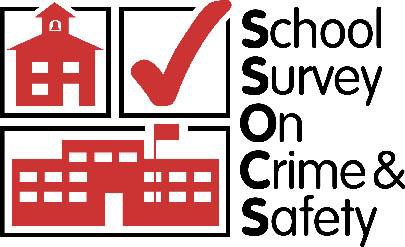
2022 School Survey on Crime and Safety (SSOCS:2022)
OMB# 1850-0761 v.22
Appendix A – Communication Materials
National Center for Education Statistics
Institute of Education Sciences
U.S. Department of Education
January 2021
revised July 2021
revised February 2022
Contents
2022 District Research Application Cover Letter (Districts in SSOCS) 7
2021–22 School Survey on Crime and Safety (SSOCS) Research Application 8
2022 Special Contact District Approval Form (SSOCS) 14
2020 SSOCS Questionnaire (Attachment to District Research Application) 15
2022 SSOCS Endorsements (Placeholder from SSOCS 2020 – awaiting final list) 37
2022 SSOCS Incentive Handout (handout will be half-sheet) 38
2022 Advance Letter to District Superintendent (02/10/22) 39
2022 Advance Letter to Chief State School Officer (02/10/22) 40
2022 Initial Letter to Principal - No Incentive, No E-mail (02/15/22) 41
2022 Initial Letter to Principal - No Incentive, E-mail (02/15/22) 42
2022 Initial Letter to Principal - Incentive, No E-mail (02/15/22) 43
2022 Initial Letter to Principal - Incentive, E-mail (02/15/22) 44
2022 Special District Approval Notice 45
2022 First Reminder Letter to Principal; 2nd Package – All treatments (03/08/22) 46
2022 Second Reminder Letter to Principal: 3rd Package, First Questionnaire 47
2022 Third Reminder Letter to Principal; 4th Package, Second Questionnaire (04/28/22) 48
2022 Initial E-mail to Principal – Before Treatment 49
2022 Initial E-mail to Principal – After Treatment 50
2022 First reminder e-mail to principals – All Treatments (03/15/22) 51
2022 Second reminder E-mail – All Treatments (04/05/22) 52
2022 Third reminder e-mail – All Treatments (04/19/22) 53
2022 Fourth Reminder e-mail – All Treatments (05/05/22) 54
2022 Fifth Reminder e-mail – All Treatments (TBD date in late May 2022) 55
2022 Sixth Reminder e-mail – All Treatments (TBD date in early June 2022) 56
2022 Seventh Reminder e-mail – All Treatments (TBD data in June 2022) 57
2022 Reminder email – All Treatments (TBD in the Spring or Summer of 2022) 58
2022 Thank You Email to Principals (August 2022) 59
2022 Letter to Principal – Replacement Questionnaire 60
2022 Thank You Letter to Principal (August 2022) 61
2022 Thank You Letter to District (August 2022) 62
2022 Frequently Asked Questions (to be included on the back of initial letter to principal) 63
2022 SSOCS Web Instrument Text (SSOCS 2020 placeholder screenshots) 64
2022 SSOCS Webpage Text (placeholder from SSOCS 2020) 75
2022 SSOCS Trifold Brochure

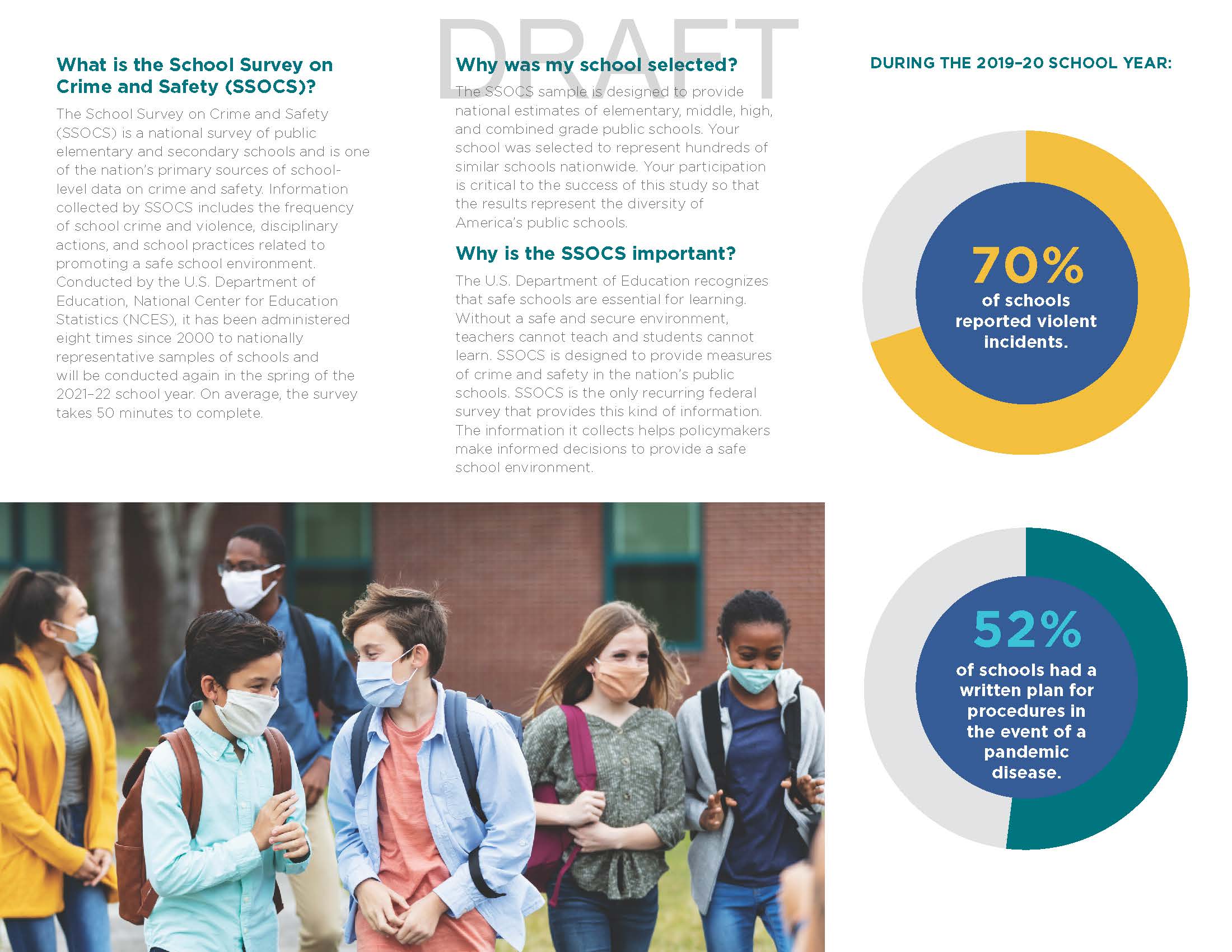 2022
District Research Application Cover Letter (Districts in SSOCS)
2022
District Research Application Cover Letter (Districts in SSOCS)

[Name] [date]
[Position, Department]
[School District]
[Street Address]
[City, State, Zip]
Dear [District Contact Name]
The National Center for Education Statistics (NCES) of the U.S. Department of Education is requesting approval to conduct the School Survey on Crime and Safety (SSOCS) 2022 in some of your district’s schools during the 2021–22 school year.
SSOCS is administered on a recurring basis by the U.S. Census Bureau on behalf of NCES. Its data are crucial in helping legislators and education leaders make informed decisions to provide a safe school environment. By participating in this survey, you will ensure that information about your district’s schools is included in those decisions.
[For districts where sample has been drawn, insert: “From your district, XX schools were sampled for SSOCS.”] No student, faculty, or classroom time is involved in this survey.
The enclosed application and materials describe the purposes, survey topics, sample size, and respondent burden for SSOCS. The SSOCS 2020 questionnaire is also included for your reference. Only minor changes are proposed for the 2022 questionnaire, which include the addition of items related to the coronavirus pandemic. In addition, a District Approval Form is enclosed for you to indicate whether your district has approved participation in SSOCS. Please return the form as soon as possible to the contact listed on the form.
If you have any questions about SSOCS or the research application, you may contact us via e-mail at [email protected] or by telephone at 1–888–595–1332. You can find additional information about SSOCS and results from prior SSOCS administrations at http://www.nces.ed.gov/surveys/ssocs.
Thank you for your consideration of the SSOCS 2022 research application.
Sincerely,
Rachel Hansen
Project Director
School Survey on Crime and Safety
National Center for Education Statistics (NCES)
PCP, 550 12th St., SW, 4th floor, Room 4036
Washington, DC 20202
Enclosures
2021–22 School Survey on Crime and Safety (SSOCS) Research Application
Contact
Applicant: Rachel Hansen
Title: Project Director
Affiliation: National Center for Education Statistics (NCES) Institute of Education Sciences (IES)
United States Department of Education Address: PCP, 550 12th Street, SW, 4th floor, Room 4036
Washington, DC 20202
Phone: (202) 245-7082
E-mail: [email protected]
SSOCS Research Application Contact:
U.S. Department of Commerce
Economics and Statistics Administration
U.S. Census Bureau
4600 Silver Hill Road, Stop 8400
Washington, DC 20233
1–888–595–1332
Title of Study: 2021–22 School Survey on Crime and Safety (SSOCS:2022)
Anticipated Start Date: February 2022
Anticipated End Date: June 2022
Purpose of Study:
The School Survey on Crime and Safety (SSOCS) is conducted by the National Center for Education Statistics (NCES), part of the Institute of Education Sciences (IES), within the United States Department of Education, in order to collect extensive data on issues of crime and safety in U.S. public primary, middle, high, and combined-grade schools. The survey asks school principals about topics such as incidents of crime and violence; disciplinary actions; discipline problems; use of security measures; school policies and practices related to school crime and violence; violence prevention programs and activities; the presence and role of school security staff; parent and community involvement; staff training; availability of mental health services; and other school characteristics. NCES is authorized to conduct SSOCS by the Education Sciences Reform Act of 2002 (ESRA 2002; 20 U.S.C. §9543).
SSOCS is one of the nation’s few sources of national information on school crime and safety, as reported by principals in U.S. public schools. SSOCS was first conducted during the 1999–2000 school year and was conducted again during the 2003–04, 2005–06, 2007–08, 2009–10, 2015–16, 2017–18, and 2019–20 school years. Many topics in the prior administrations are repeated in the 2021–22 questionnaire to enable comparisons between the nine survey periods. Because data are collected on a recurring basis, it is possible to assess whether our nation’s schools are becoming safer for students and educators. By participating, information from schools in your district allows for comparisons among different types of schools across the nation that are valuable to governing agencies, policy makers, educators and the general public.
Significance of the Study and Benefits of Participation:
SSOCS collects detailed information on the incidence, frequency, seriousness, and nature of violence affecting students and school personnel, as well as other indices of school safety from the schools’ perspective. As such, it fills an important gap in data collected by NCES and other agencies. With the help of survey participants, NCES is able to produce national estimates of school crime and discipline, and of school policies and programs concerning crime and safety. These data are crucial in helping legislators and education leaders make informed decisions to provide a safe school environment. The ability of NCES to provide this important information is contingent upon the voluntary participation of sampled schools; participation of these schools is dependent upon their districts’ approval. Because your district and its schools represent themselves and many others like them, their participation is vital for producing high quality information. By participating in this survey, you will ensure that information about your districts’ schools is included in those important decisions.
The SSOCS questionnaire is divided into 9 broad research objectives, each with a series of measurement items addressing a specific research question. Each research objective is briefly stated below in terms of the crime and safety issues in need of measurement, as well as the research questions we are seeking to answer. These measurement items and corresponding research questions are:
School Practices and Policies: practices to prevent/reduce crime and violence at public schools
How do schools monitor student behavior?
How do schools control student behavior?
How do schools monitor and secure the physical grounds?
How do schools limit access to the school?
How do schools plan and practice procedures for emergencies?
How do schools plan for pandemic diseases?
Parent and Community Involvement at School
How do schools involve parents?
What type of community groups are involved with the school?
School Security Staff: involvement of law enforcement at public schools
Do schools have sworn law enforcement officers present on a regular basis?
How often are they available and at what times?
What activities do they participate in?
How many are present at the school?
How are sworn law enforcement officers armed?
Is there written documentation outlining the roles and responsibilities of law enforcement in schools?
Do schools have security guards or personnel other than law enforcement?
School Mental Health Services: availability and access to student mental health services at public schools
Are mental health services, such as diagnostic assessment and treatment, available to students?
Where are those services available?
What factors limit a school’s efforts to provide mental health services to students?
Staff Training and Practices
What type of district provided training for teachers was provided?
Were there staff authorized to carry firearms?
Limits on Crime Prevention
Are there factors which limit a school’s efforts to reduce crime?
Incidents
What is the number of incidents, by type of crime?
What are the characteristics of those incidents?
How many incidents were reported to police?
What is the number of hate-crime incidents?
What biases motivated these incidents?
How many arrests were made at school?
How many schools report violent deaths?
How many schools report school shootings?
How many schools report disruptions for violent threats?
Disciplinary Problems and Actions: disciplinary actions used by public schools
What types of disciplinary actions were available to principals?
How many disciplinary actions were taken, by type of action and offense?
School Characteristics which are related to the research questions above
What are the demographic characteristics of schools?
What are the characteristics of the student population?
What is the average student/teacher ratio?
What are the general measures of school climate, such as truancy or student mobility?
A copy of the 2022 SSOCS questionnaire is enclosed for your reference. Additional information about SSOCS and results from prior SSOCS administrations is available at http://nces.ed.gov/surveys/ssocs.
The SSOCS:2022 questionnaire consists of the following sections:
School practices and programs;
Parent and community involvement at school;
School security staff;
School mental health services;
Staff training and practices;
Limitations on crime prevention;
Incidents;
Disciplinary problems and actions; and
School characteristics: 2021–22 school year
Respondent information.
The U.S. Census Bureau collects the SSOCS data on behalf of NCES. SSOCS is a self-administered survey that is offered to respondents via an online and paper questionnaire. An online questionnaire will be offered to all respondents in SSOCS:2022 and a paper questionnaire will be provided as requested, and with the third and fourth mail contacts with schools. Additionally, all schools will be offered a cash incentive for participating. Principals, or the school staff most knowledgeable about school crime and policies for a safe environment, can complete the survey via the online questionnaire or mail it directly to the U.S. Census Bureau. School districts and state educational agencies are not involved in the data collection in any way. Depending on the school’s data collection system, some principals may seek input from other school staff, such as school resource officers or guidance counselors. The survey does not require the participation of either students or faculty. No classroom time is involved in the completion of this survey.
SSOCS provides aggregate estimates for public schools across the nation. A stratified sample design is used to select approximately 4,800 U.S. public schools for SSOCS:2022. The sample is designed to provide national estimates of primary, middle, high, and combined-grade schools taking into account the level of instruction, type of locale (urbanicity), and size of the student enrollment.
The sampling frame for SSOCS is derived from the Common Core of Data (CCD), the universe of public schools supplied annually by state educational agencies to NCES. Only public schools in the 50 states and the District of Columbia are included in the SSOCS sampling frame. Certain types of schools are excluded, including special education schools, vocational schools, alternative schools (e.g., adult continuing education schools and remedial schools), newly closed schools, home schools, virtual schools, ungraded schools, schools with high grades of kindergarten or lower, and schools run by the Bureau of Indian Education. Regular public schools, charter schools, and schools that have partial or total magnet programs are included in the frame. For sample allocation purposes, strata are defined by instructional level, type of locale (urbanicity), and enrollment size. Both percent minority enrollment and region are used as sorting variables in the sample selection process to induce implicit stratification.
The 2021–22 SSOCS data collection will begin in February of 2022. The U.S. Census Bureau, acting as a contractor for NCES, will handle the data collection. Sampled schools will receive a letter notifying them of the survey in February 2022, which will include the log on information to complete the online questionnaire. If the surveys are not returned or items are left incomplete, the school may receive follow-up telephone calls and emails. All follow-up data collection activities will end in June 2022. Completed questionnaires are sent directly back to the U.S. Census Bureau.
SSOCS:2022 timetable |
|
Questionnaire Log-In Information sent to principals |
February 2022 |
Questionnaires due from principals |
March 2022 |
Phone and email follow-up with non-responders begins |
March 2022 |
All data collection efforts end |
June 2022 |
SSOCS relies on the voluntary participation of schools. The quality of national estimates is dependent on the level of respondent participation. The data provided by individual schools are combined with the information provided by other schools in statistical reports to present estimates of school crime and discipline, and of school policies and programs concerning crime and safety in schools nationwide. Every effort is made to create questionnaires that collect in-depth data without putting an undue burden on the respondent. The response burden for the survey is estimated to be 60 minutes per school.
The recruitment materials and questionnaire clearly state that SSOCS:2022 is a voluntary survey. The materials also state that the data will only be reported in statistical summaries that preclude the identification of any individual principal or school participating in the survey.
Analysis and Release of Information:
The information collected in the 2021–22 SSOCS will be released in several ways. Many of the estimates will be included in statistical analysis reports published by NCES. In addition, the major findings will be included on the NCES website.
NCES allows researchers to access the data through restricted-use licensing for additional analyses. Only users who have official clearance from NCES may have access to the restricted-use data files. The data will be made available to the public as soon as possible after data collection. A public use dataset will be made available to the public on the Department of Education web site. In compliance with NCES confidentiality procedures, the public use dataset will not contain any information that can be used to identify an individual school or the state or district in which the school is located.
Benefit to Your School District:
The U.S. Department of Education recognizes that safe schools are essential for learning: without a safe and secure environment, teachers cannot teach and students cannot learn. Effective data collection that encourages a high level of participation, and clear and timely analysis and presentation of the data, provide educators with a powerful set of tools for achieving the goal of school safety by providing accurate, up-to-date information about school crime and safety. This information is crucial in helping legislators and education leaders make informed decisions to provide a safe school environment. The ability of NCES to provide this important information is contingent upon the voluntary participation of sampled schools, and participation of these schools is dependent upon their districts’ approval. Because your district and its schools represent themselves and many others like them, their participation is vital for producing high quality information. By participating in this survey, you will ensure that information about your districts’ schools is included in those important decisions.
Data security and confidentiality protection procedures have been put in place for SSOCS:2022 to ensure that all contractors and agents working on SSOCS comply with all privacy requirements including, as applicable:
The Inter-agency agreement with NCES for this study and the statement of work of SSOCS contract;
Privacy Act of 1974 (5 U.S.C. §552a);
Privacy Act Regulations (34 CFR Part 5b);
Computer Security Act of 1987;
U.S.A. Patriot Act of 2001 (P.L. 107-56);
Education Sciences Reform Act of 2002 (ESRA 2002, 20 U.S.C. §9573);
Cybersecurity Enhancement Act of 2015 (6 U.S.C. §151);
Foundations of Evidence-Based Policymaking Act of 2018, Title III, Part B, Confidential Information Protection
The U.S. Department of Education General Handbook for Information Technology Security General Support Systems and Major Applications Inventory Procedures (March 2005);
The U.S. Department of Education Incident Handling Procedures (February 2009);
The U.S. Department of Education, ACS Directive OM: 5-101, Contractor Employee Personnel Security Screenings;
NCES Statistical Standards; and
All new legislation that impacts the data collected through the inter-agency agreement and contract for this study.
The U.S. Census Bureau will collect data under an interagency agreement with NCES, and maintain the individually identifiable questionnaires per the agreement, including:
Provisions for data collection in the field;
Provisions to protect the data-coding phase required before machine processing;
Provisions to safeguard completed survey documents;
Authorization procedures to access or obtain files containing identifying information; and
Provisions to remove printouts and other outputs that contain identification information from normal operation (such materials will be maintained in secured storage areas and will be securely destroyed as soon as practical).
U.S. Census Bureau and contractors working on SSOCS:2022 will comply with the Department of Education’s IT security policy requirements as set forth in the Handbook for Information Assurance Security Policy and related procedures and guidance, as well as IT security requirements in the Federal Information Security Management Act (FISMA), Federal Information Processing Standards (FIPS) publications, Office of Management and Budget (OMB) Circulars, and the National Institute of Standards and Technology (NIST) standards and guidance. All data products and publications will also adhere to the revised NCES Statistical Standards, as described at the website: https://nces.ed.gov/statprog/2012/.
By law (20 U.S.C. §9573), a violation of the confidentiality restrictions is a felony, punishable by imprisonment of up to 5 years and/or a fine of up to $250,000. All government or contracted staff working on the SSOCS study and having access to the data, including SSOCS field staff, are required to sign an NCES Affidavit of Nondisclosure and have received public-trust security clearance. These requirements include the successful certification and accreditation of the system before it can be implemented. Appropriate memoranda of understanding and interconnection security agreements will be documented as part of the certification and accreditation process.
From the initial contact with the participants in this survey through all of the follow-up efforts, potential survey respondents will be informed that (a) the U.S. Census Bureau administers SSOCS on behalf of NCES; (b) NCES is authorized to conduct SSOCS by the Education Sciences Reform Act of 2002 (ESRA 2002, 20 U.S.C. §9543); (c) all of the information they provide may only be used for statistical purposes and may not be disclosed, or used, in identifiable form for any other purpose except as required by law (20 U.S.C. §9573 and 6 U.S.C. §151); and (d) that their participation is voluntary.
The following language will be included in respondent contact materials and on data collection instruments:
The National Center for Education Statistics (NCES), within the U.S. Department of Education, conducts SSOCS as authorized by the Education Sciences Reform Act of 2002 (ESRA 2002, 20 U.S.C. §9543).
All of the information you provide may be used only for statistical purposes and may not be disclosed, or used, in identifiable form for any other purpose except as required by law (20 U.S.C. §9573 and 6 U.S.C. §151).
The following language will be included on data collection instruments:
According to the Paperwork Reduction Act of 1995, no persons are required to respond to a collection of information unless it displays a valid OMB control number. The valid OMB control number for this voluntary information collection is 1850-0761. The time required to complete this information collection is estimated to average 60 minutes per response, including the time to review instructions, search existing data resources, gather the data needed, and complete and review the information collection. If you have any comments concerning the accuracy of the time estimate, suggestions for improving this collection, or comments or concerns about the contents or the status of your individual submission of this questionnaire, please e-mail: [email protected], or write directly to: School Survey on Crime and Safety (SSOCS), National Center for Education Statistics, PCP, 550 12th Street SW, #4036, Washington, DC 20202.
Institutional Review Board (IRB) or Human Subjects Review:
Under the federal policy for the protection of human subjects, SSOCS is exempt from IRB review because it utilizes survey procedures and is conducted in established or commonly accepted educational settings, involving normal educational practices. There is no potential for harm to human subjects.
The Department of Education has adopted a common set of regulations known as the Federal Policy for the Protection of Human Subjects or "Common Rule." The design of these regulations is based on established, internationally recognized ethical principles. The specific regulation is Title 34, Code of Federal Regulations, Part 97, Protection of Human Subjects, which includes Subpart A, Basic Policy, and Subpart D, Additional Protections for Children. These regulations classify as exempt certain categories of research. Research that is nonexempt is covered by the regulations. Research activities in which the only involvement of human subjects will be in one or more of the following categories are exempt [34 CFR 97.101(b)(2)]:
Research involving the use of educational tests (cognitive, diagnostic, aptitude, achievement), survey procedures, interview procedures or observation of public behavior, unless the information identifies the subjects and disclosure could reasonably place the subjects at risk of criminal or civil liability or be damaging to the subjects' financial standing, employability, or reputation. Subpart D amends this exemption, in part: If the subjects are children, research involving interview or survey procedures and research involving observations of public behavior in which the researcher(s) participate in the activities being observed are not exempt. However, research involving the use of educational tests and research involving observations of public behavior in which the researcher(s) do not participate in the activities being observed are exempt.
For more information, please see http://www2.ed.gov/policy/fund/guid/humansub/overview.html.
The nature of this self-administered, cross-sectional survey is not considered intrusive and has been ruled to be exempt under the protection of human subjects’ provisions in federal research.
There are no individual student data (such as test scores or Social Security numbers) associated with any of the data acquired in this data collection. Since no data are collected about individual students, it is not necessary to obtain active, informed consent from students’ parents/guardians.
Participation in SSOCS is completely voluntary, and individual survey items can be left blank, at the discretion of each respondent. A statement on the questionnaire indicates that participation is voluntary. A respondent gives implied consent to participate by completing the SSOCS questionnaire.
2022 Special Contact District Approval Form (SSOCS)
School Survey on Crime and Safety (SSOCS) 2022
District Approval Form
Please mark one of the boxes below to let us know your district’s decision to allow sampled school(s) to participate in the School Survey on Crime and Safety (SSOCS).
□ The U.S. Department of Education has permission to administer the School Survey on Crime and Safety (SSOCS) 2022 to one or more schools in the [District Name].
□ The U.S. Department of Education does not have permission to administer the School Survey on Crime and Safety (SSOCS) 2022 to any school in the [District Name].
Printed
Name: ___________________________ Date: ________________________
Signature: ___________________________ Title: ________________________
Address: ___________________________ Phone: _______________________
___________________________
Email: ___________________________
Please
return this form to [contact
info] by email to
[email],
or by mail to: [address]
2020 SSOCS Questionnaire (Attachment to District Research Application)
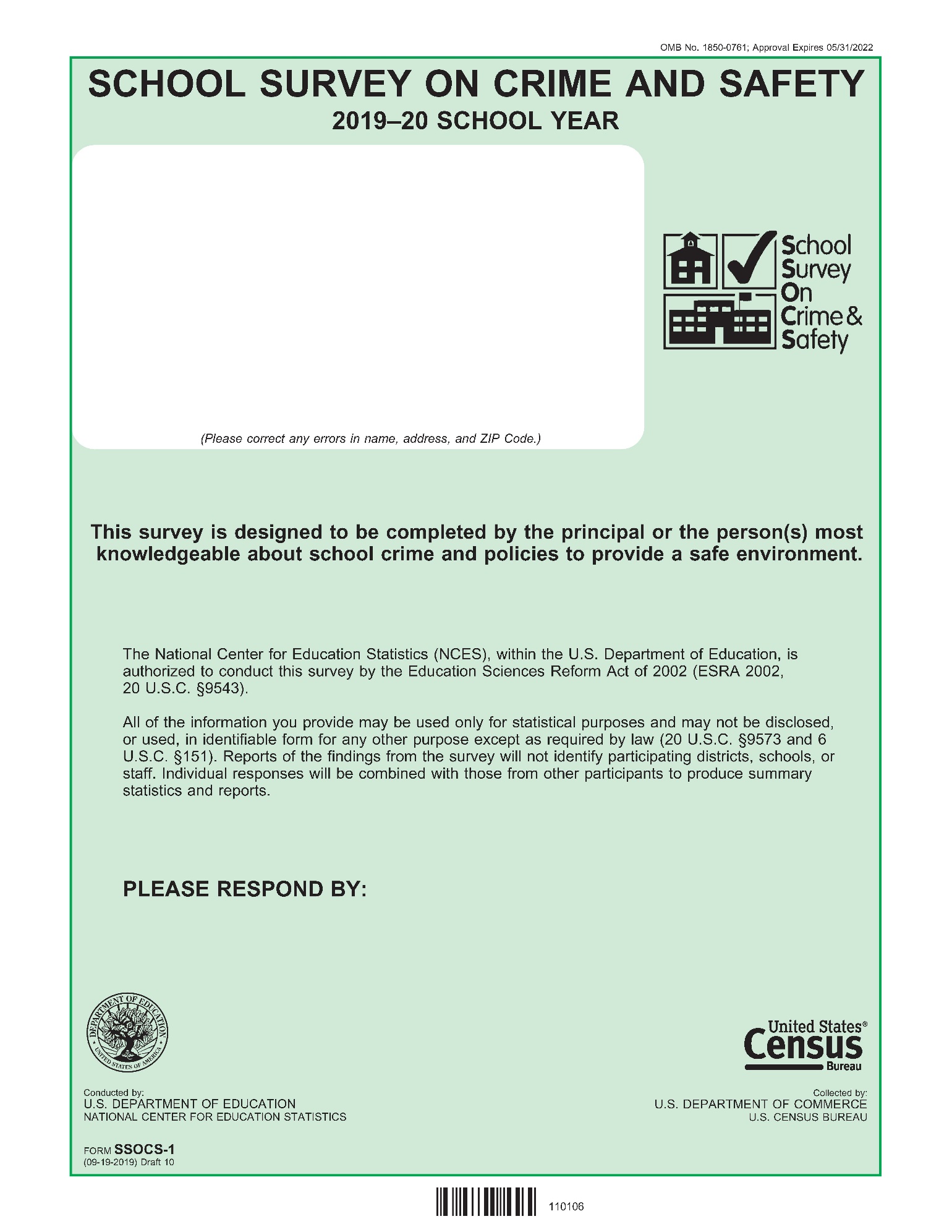
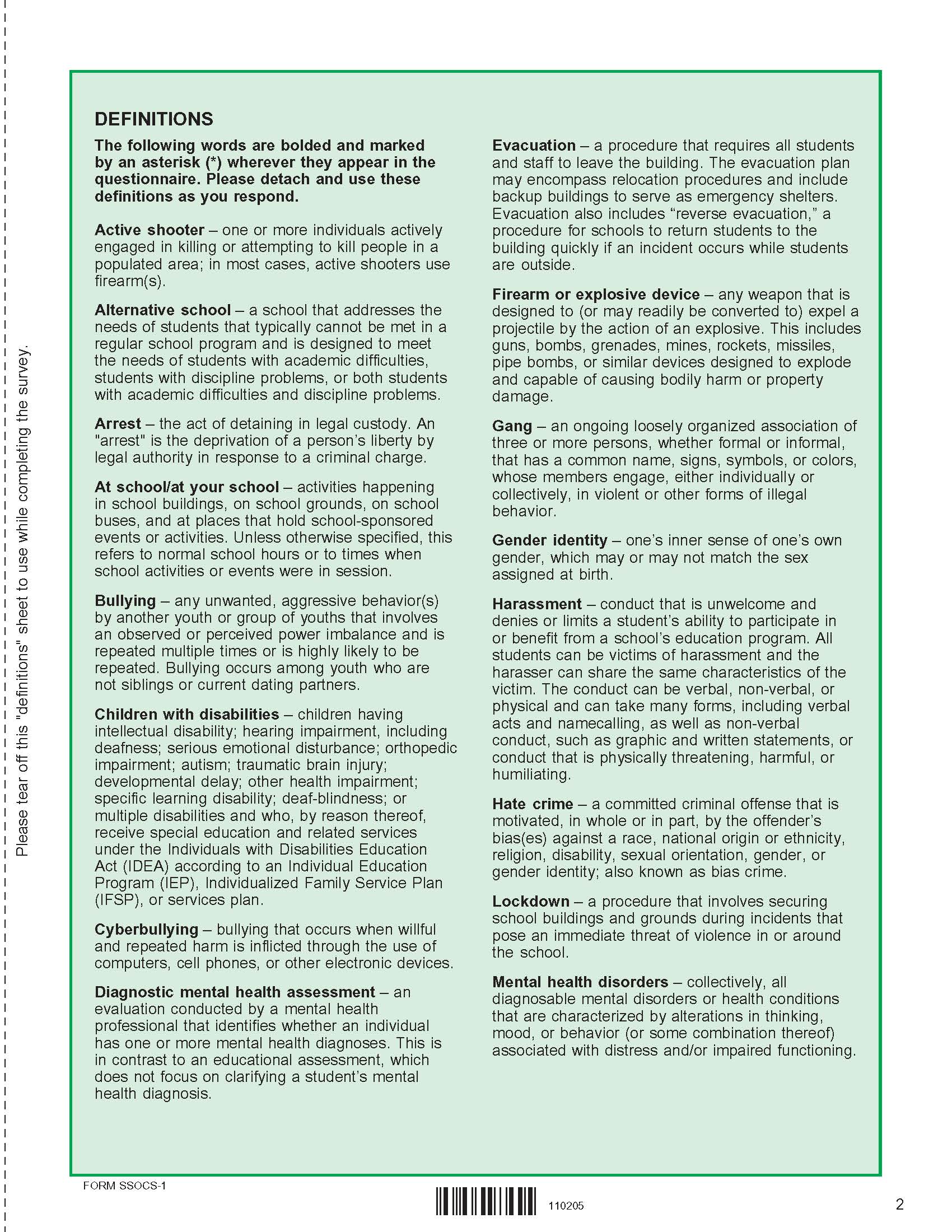
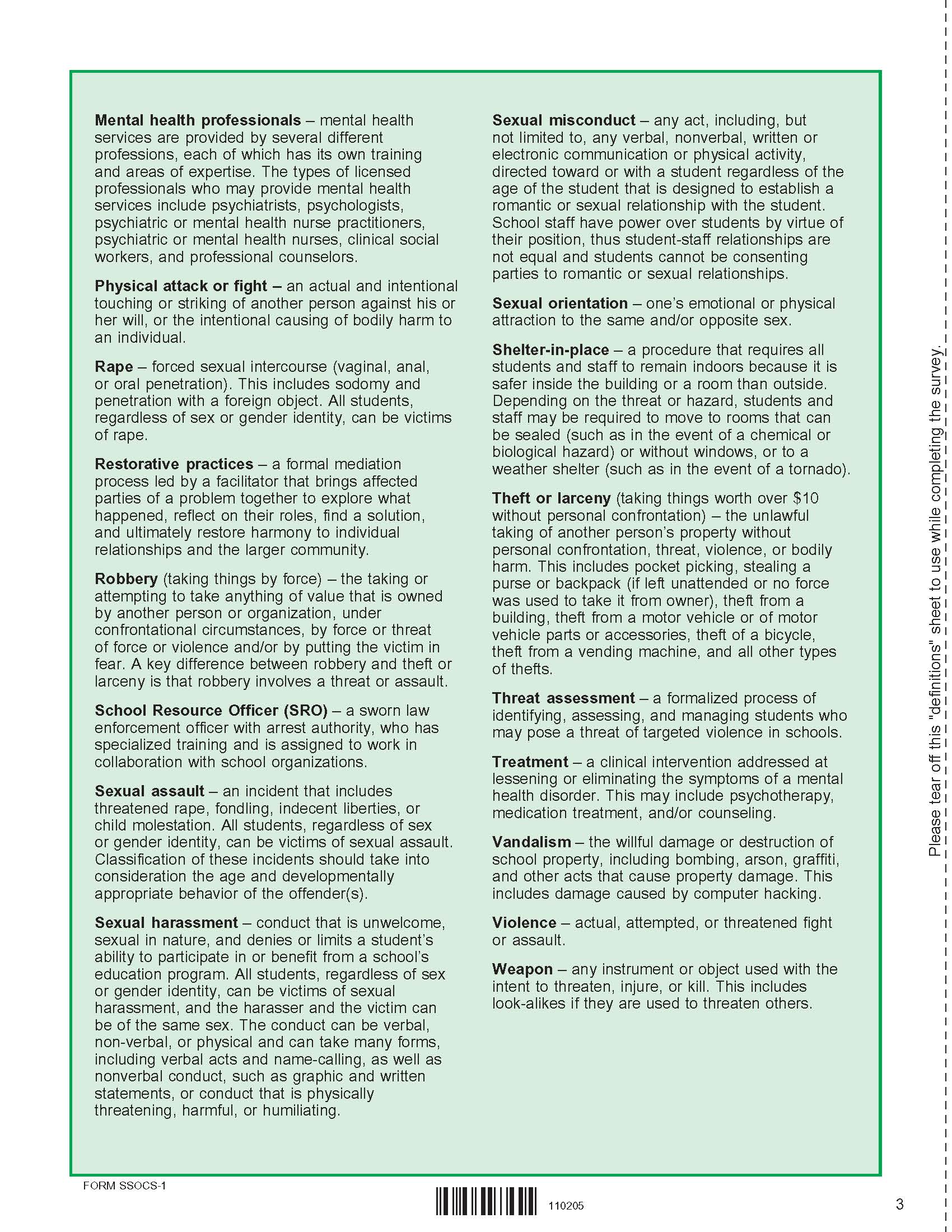
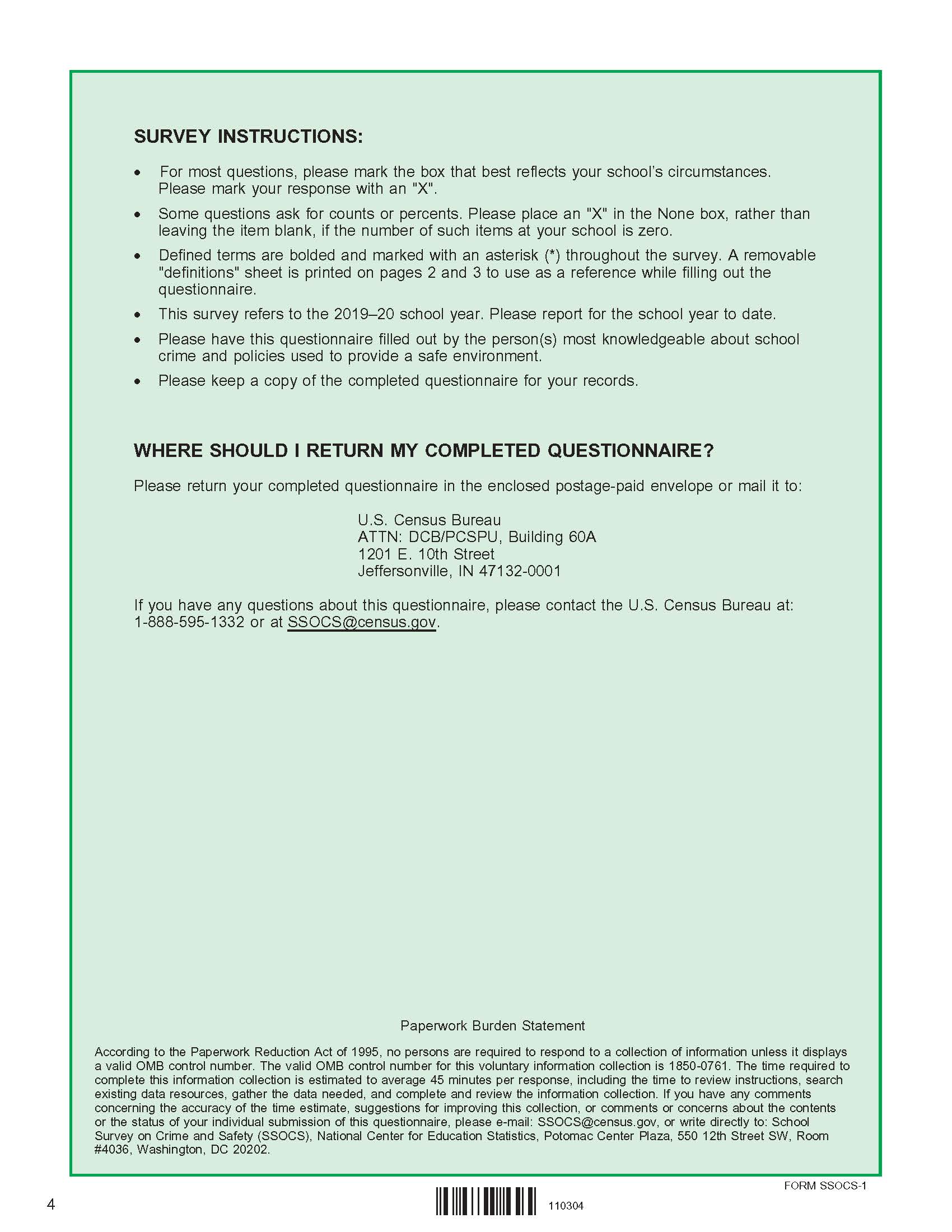
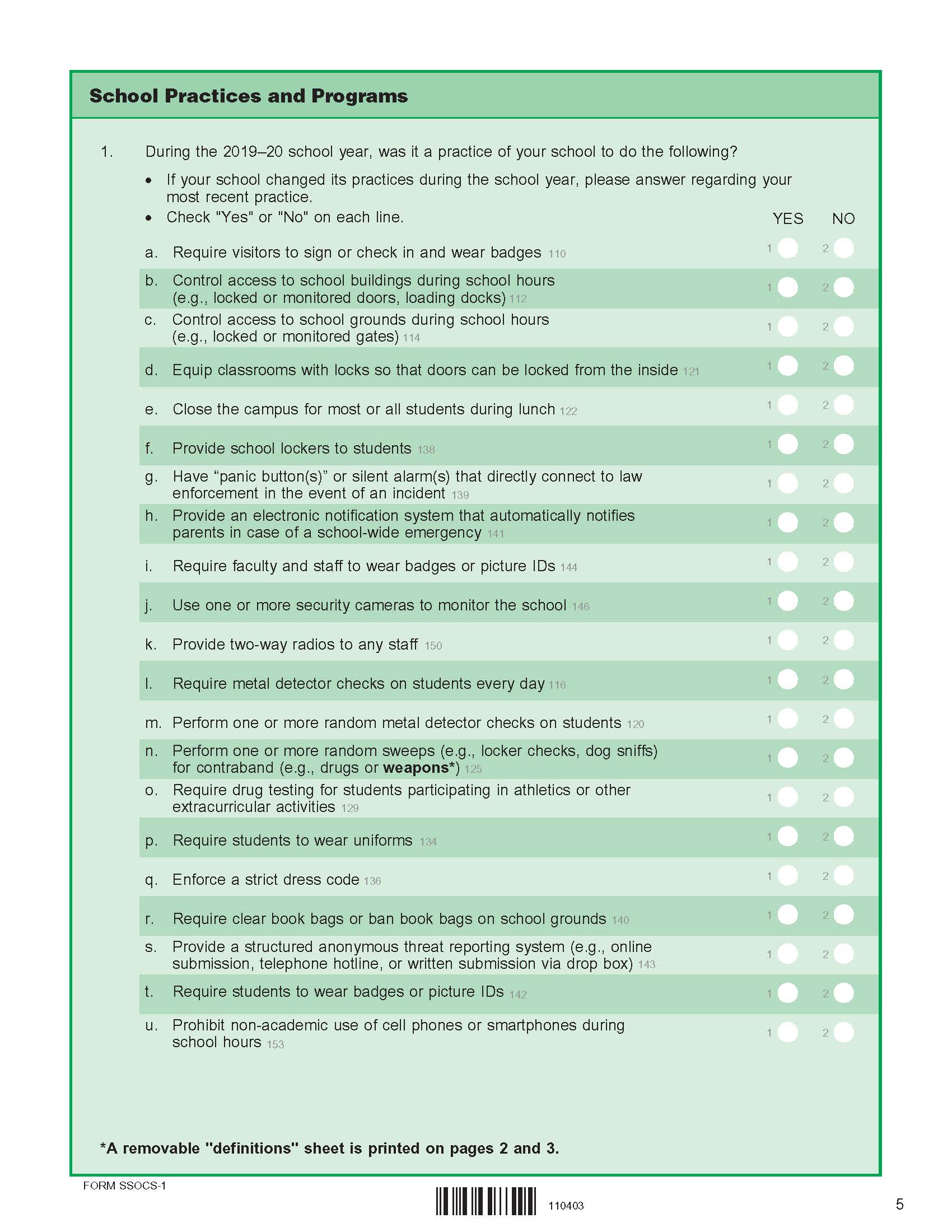
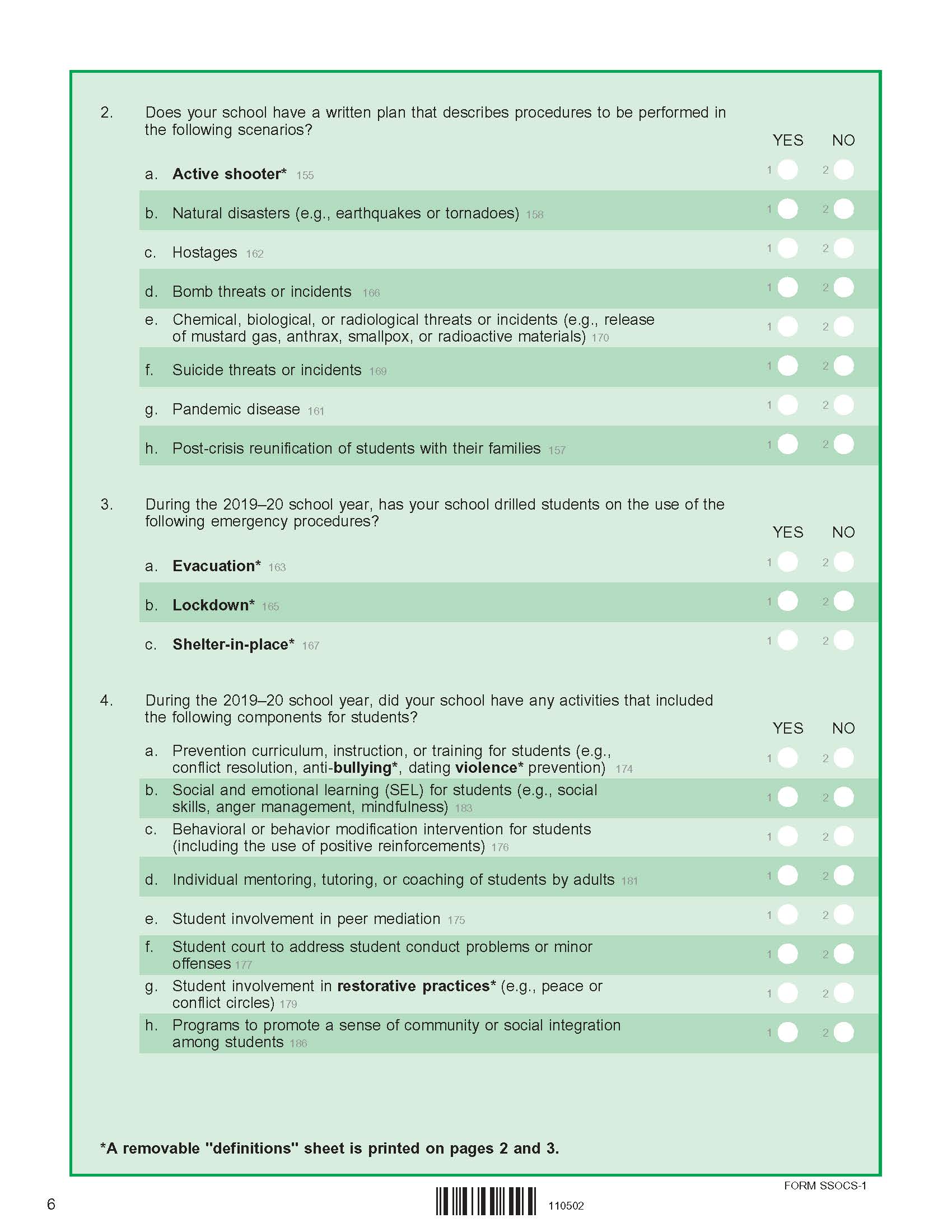
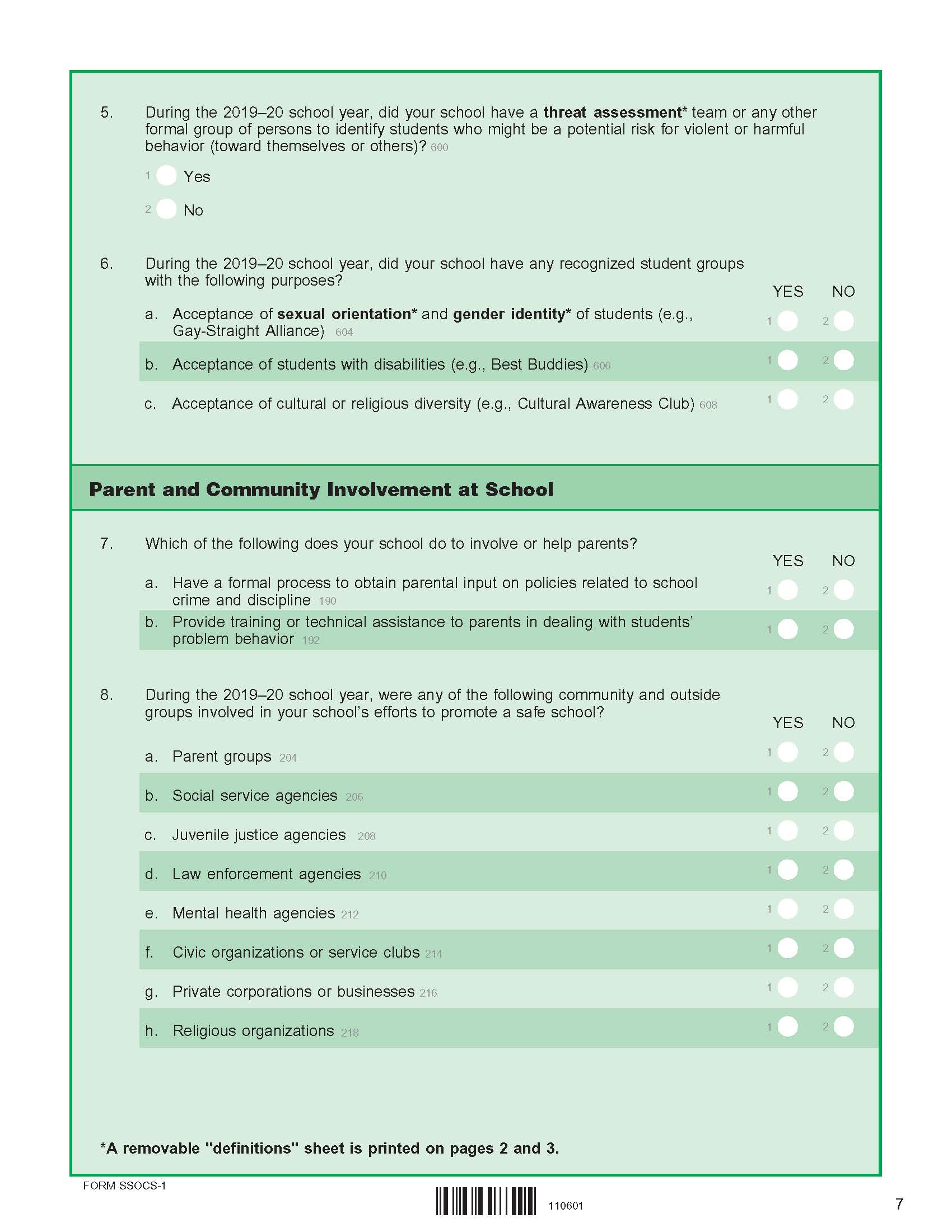

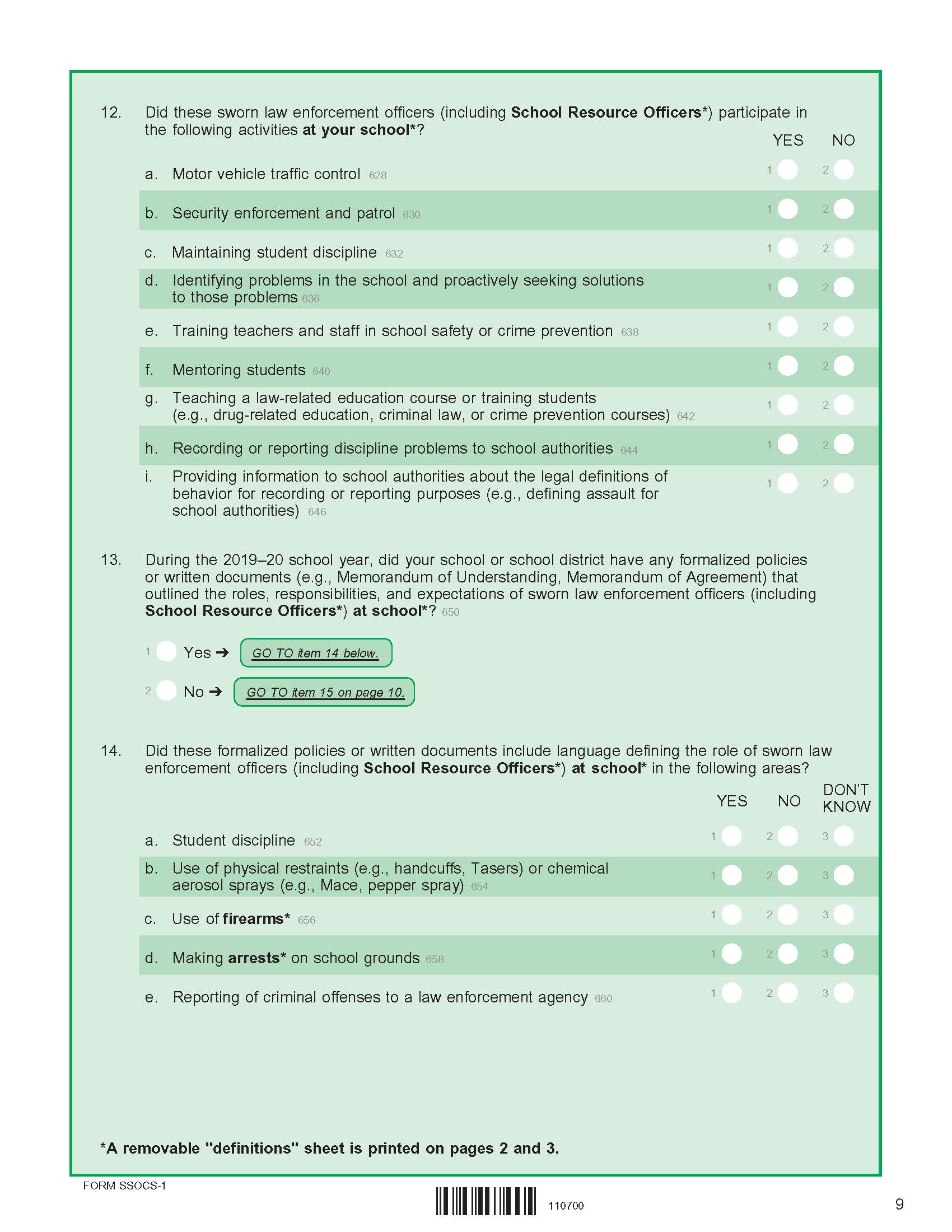
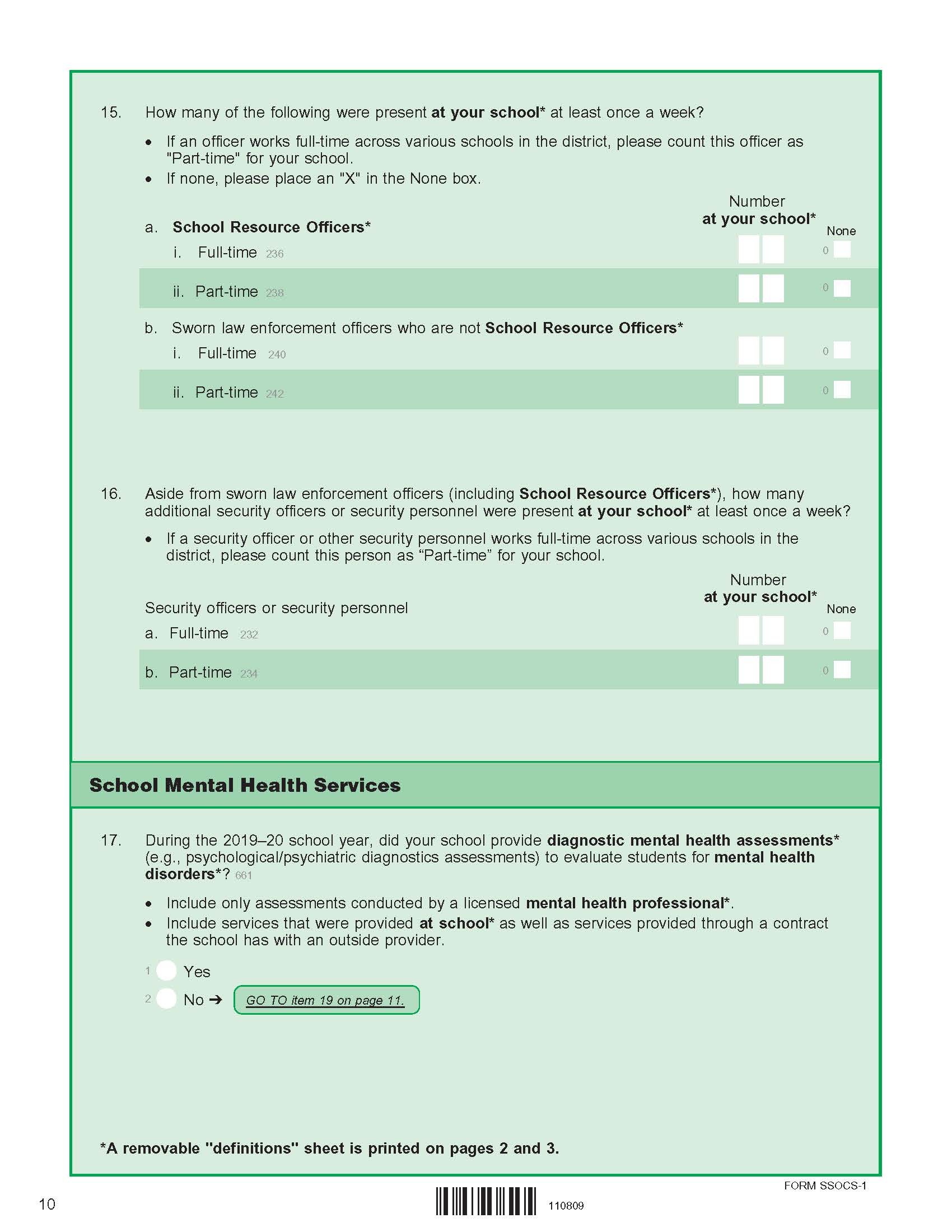
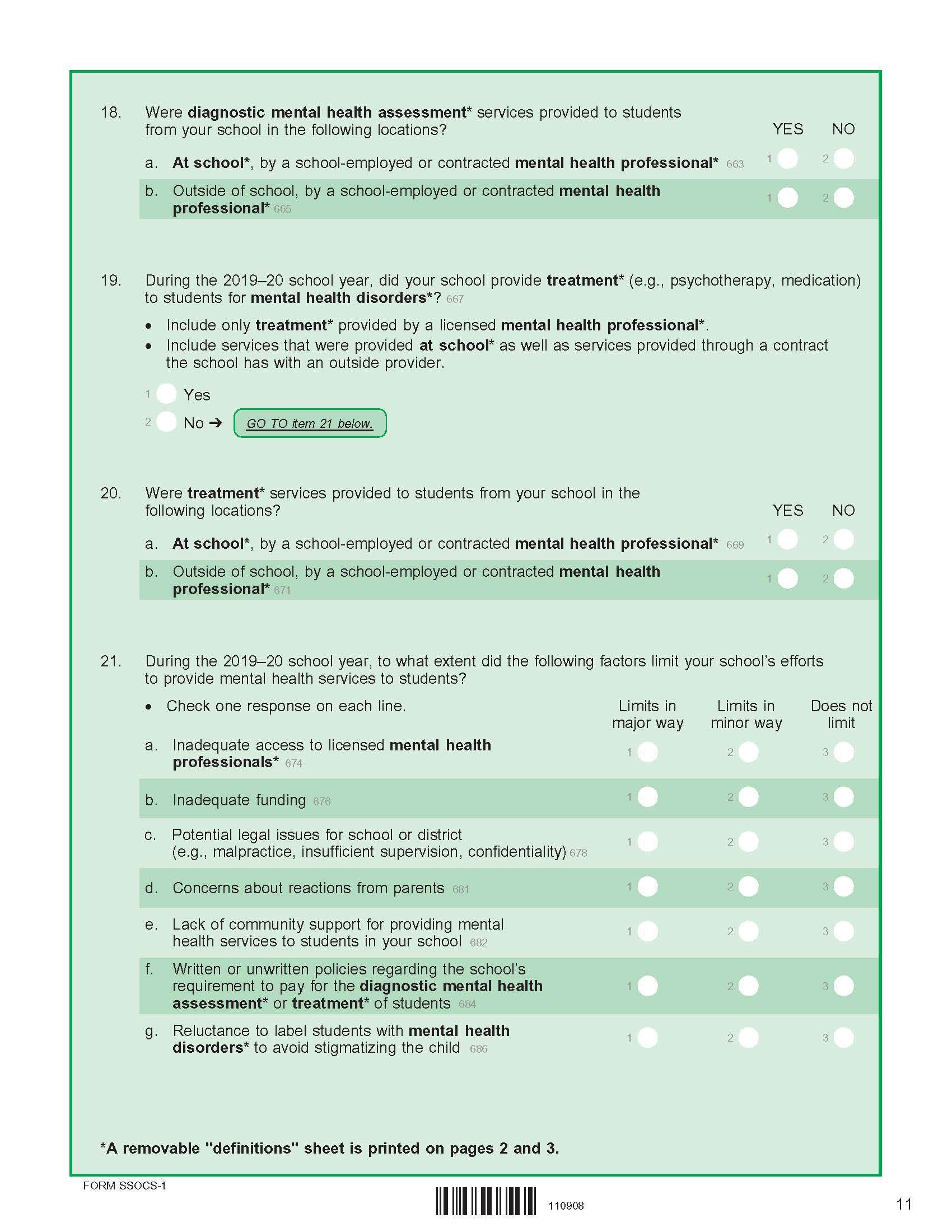
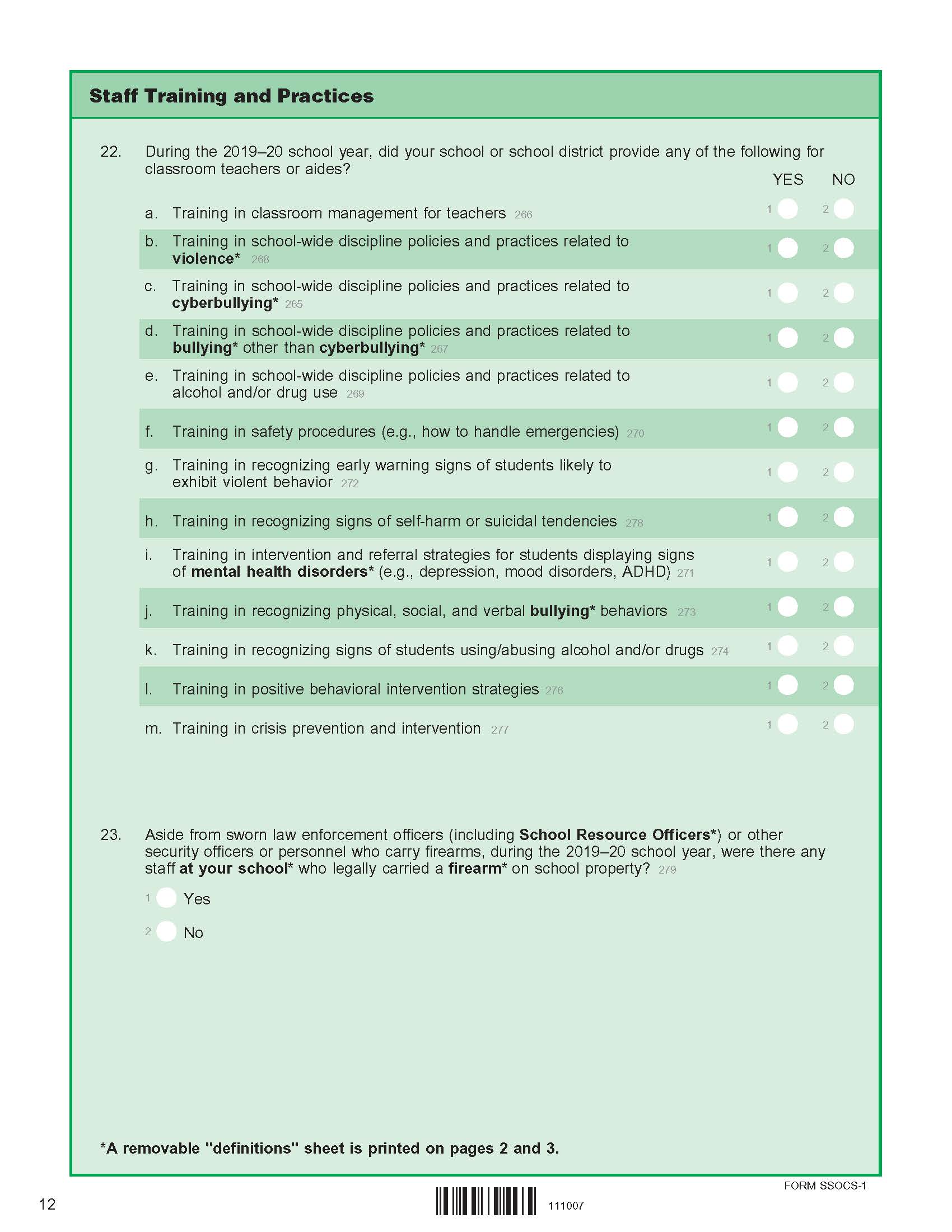
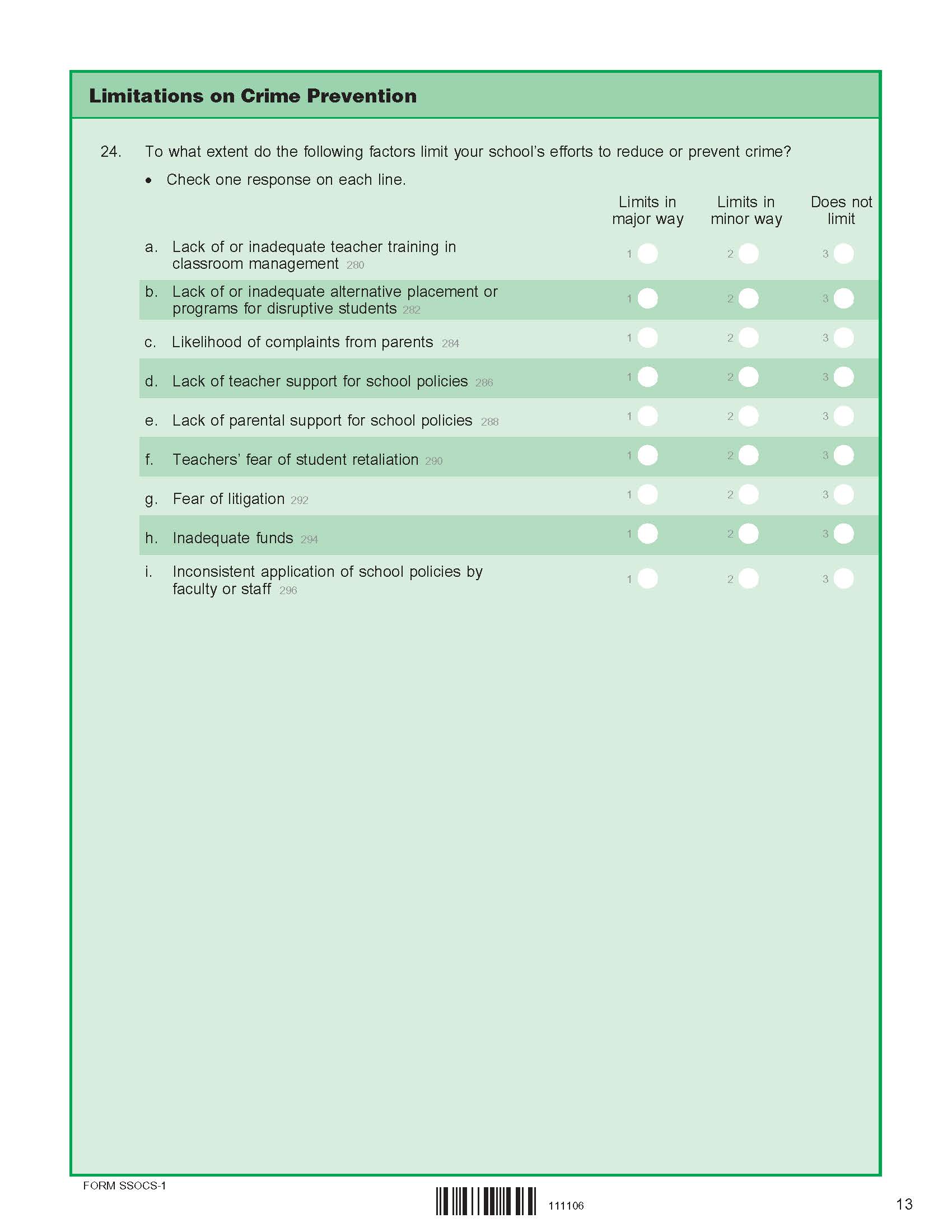
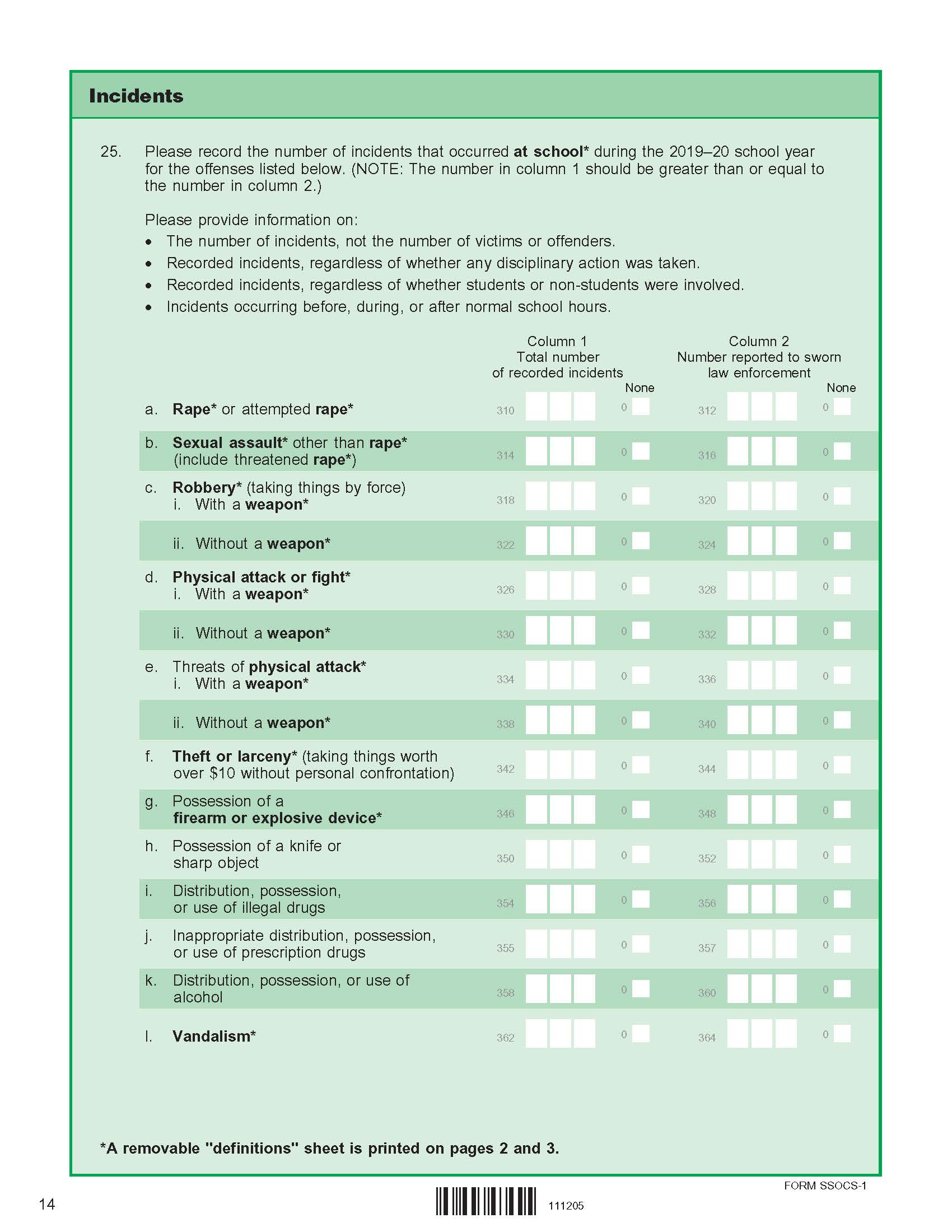
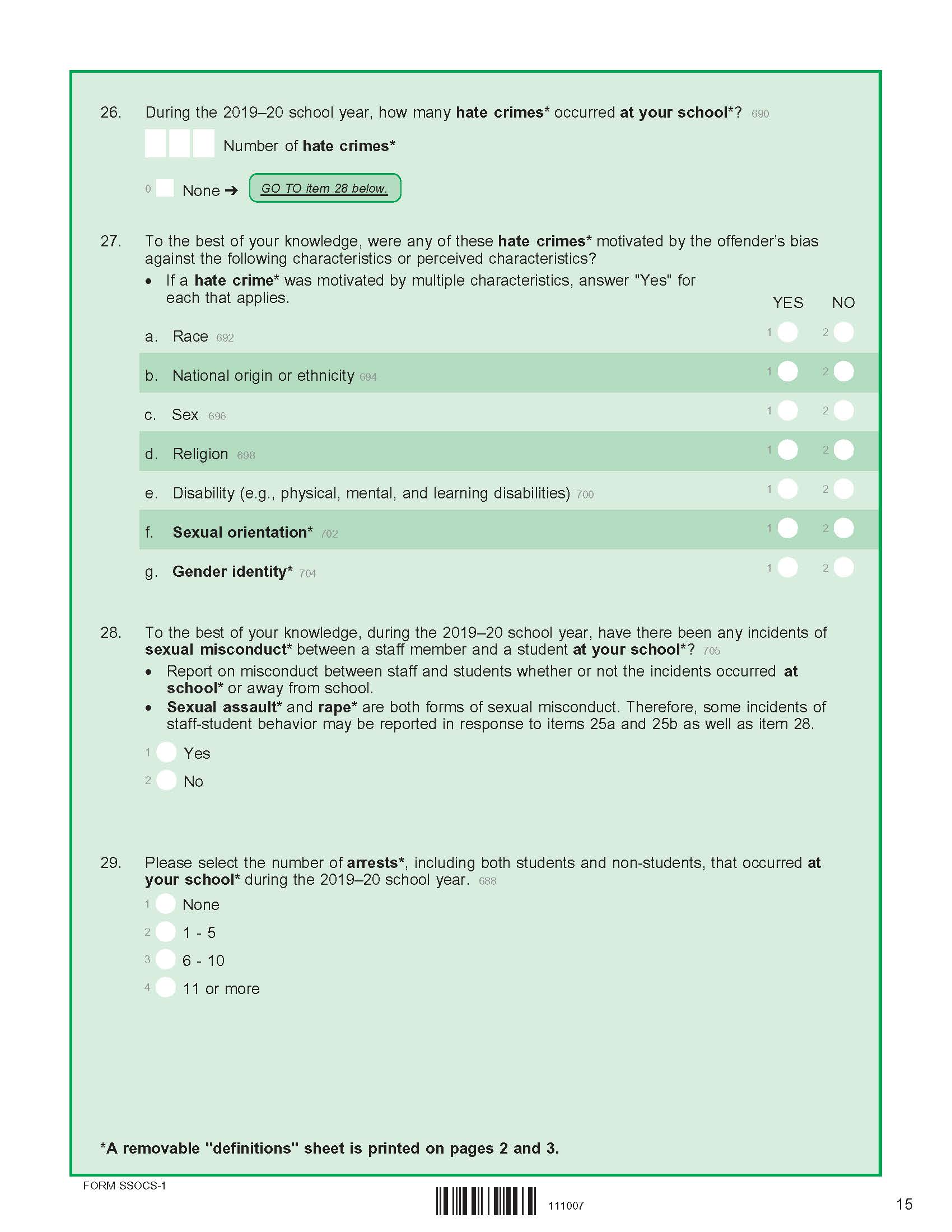
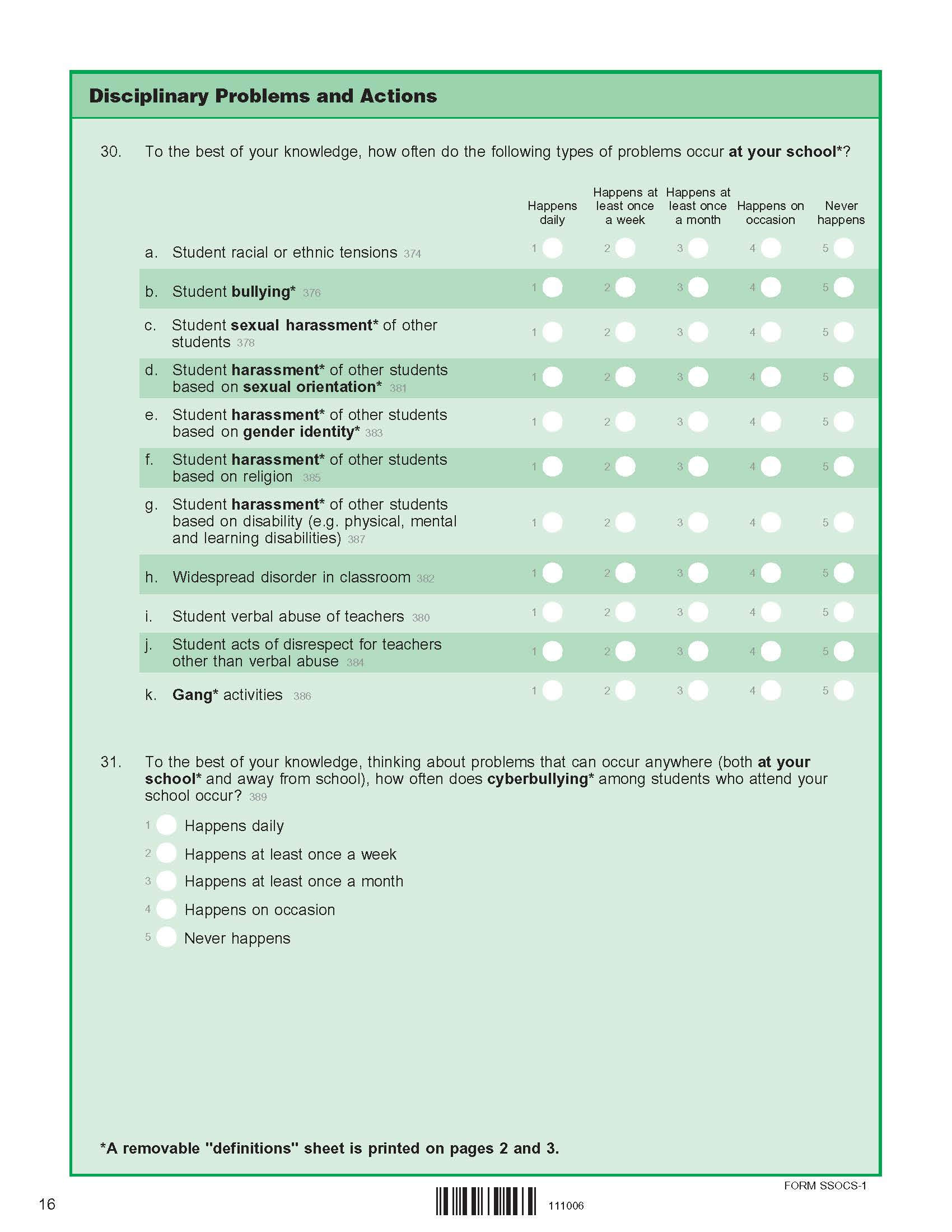
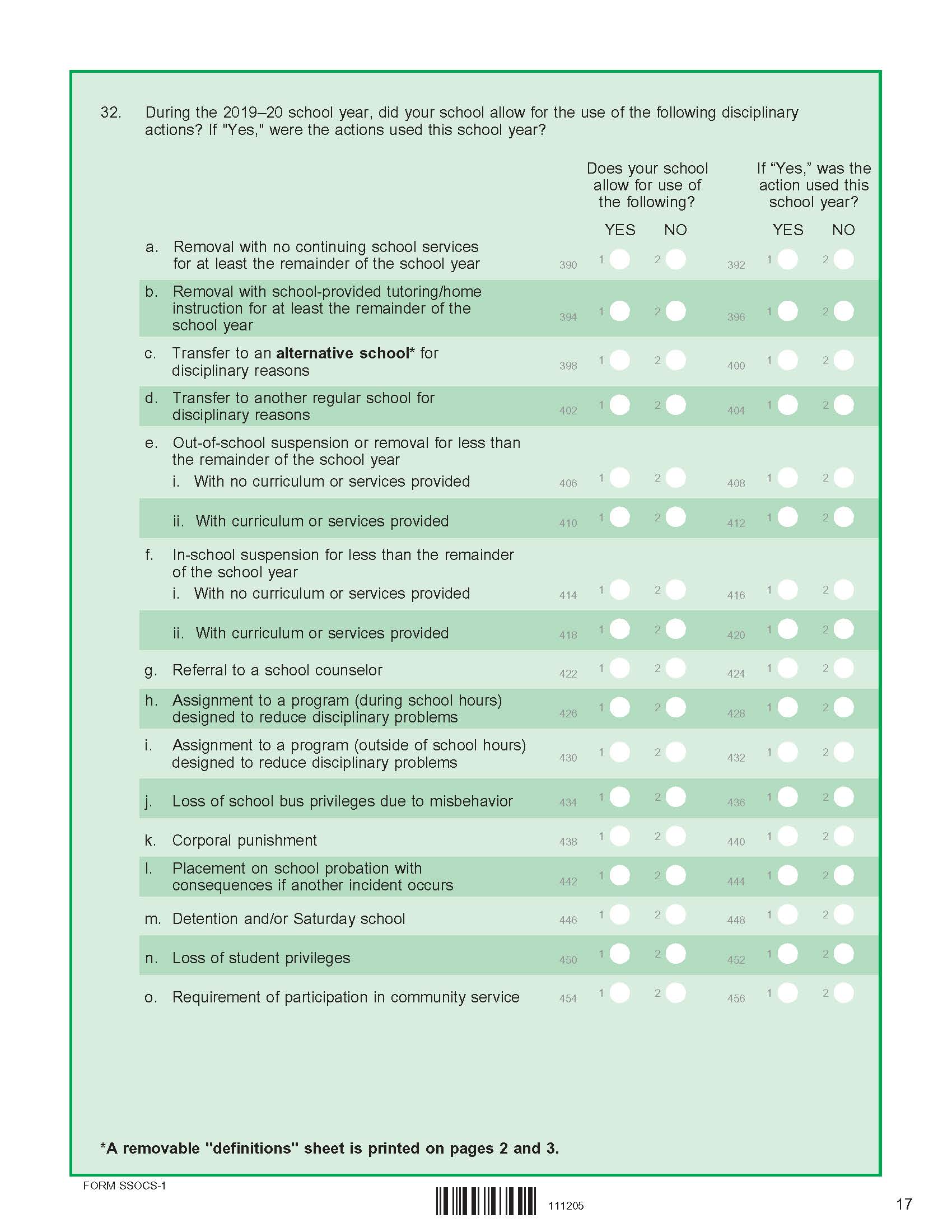
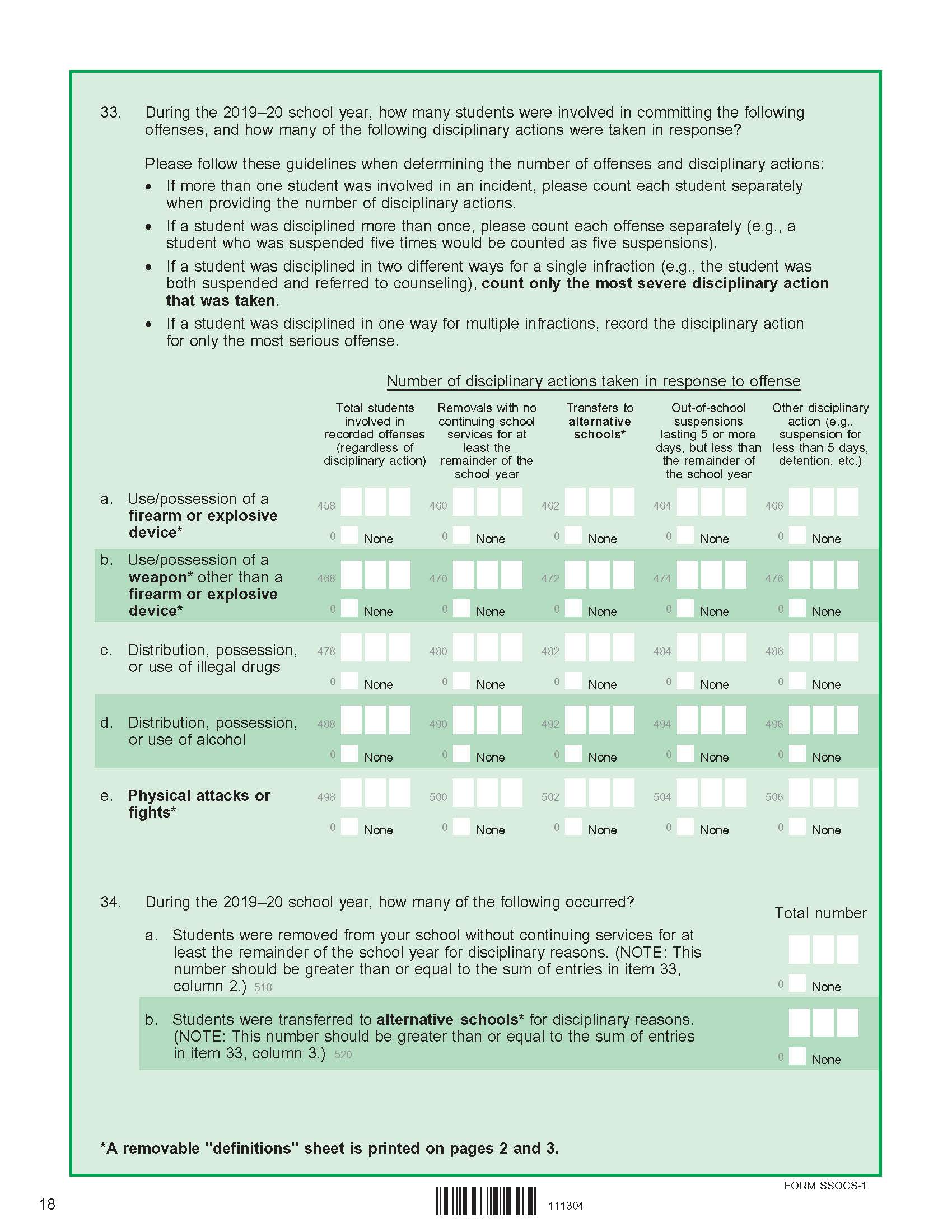

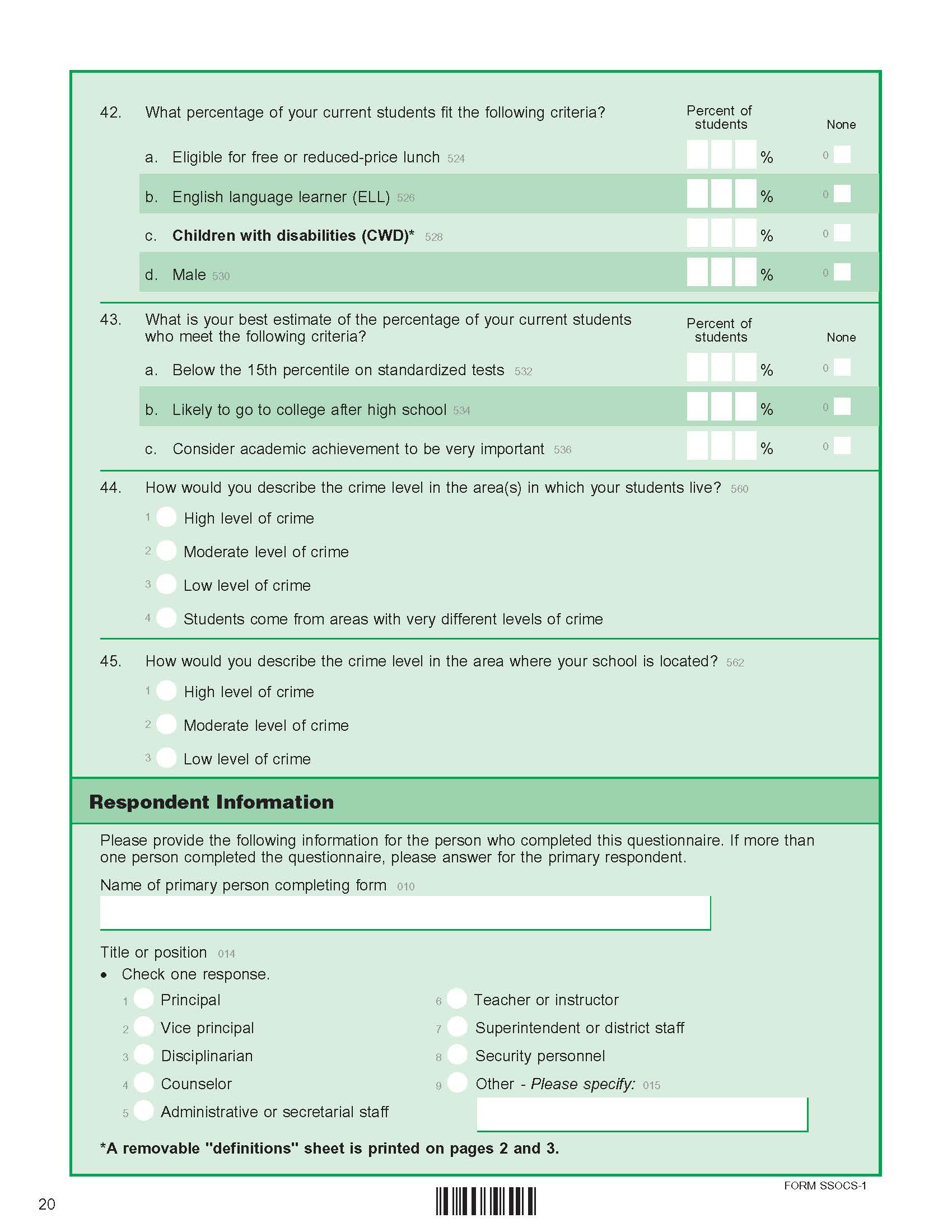
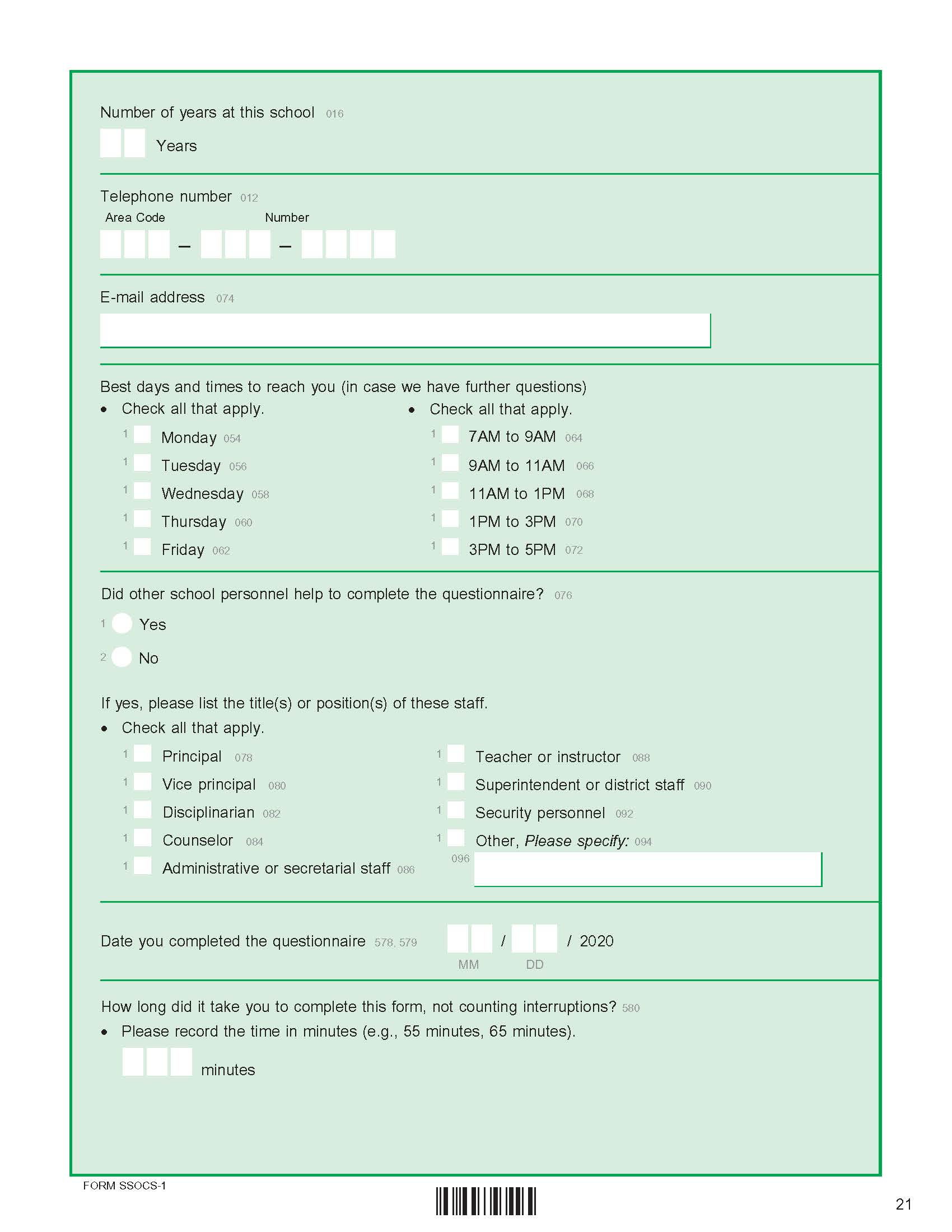
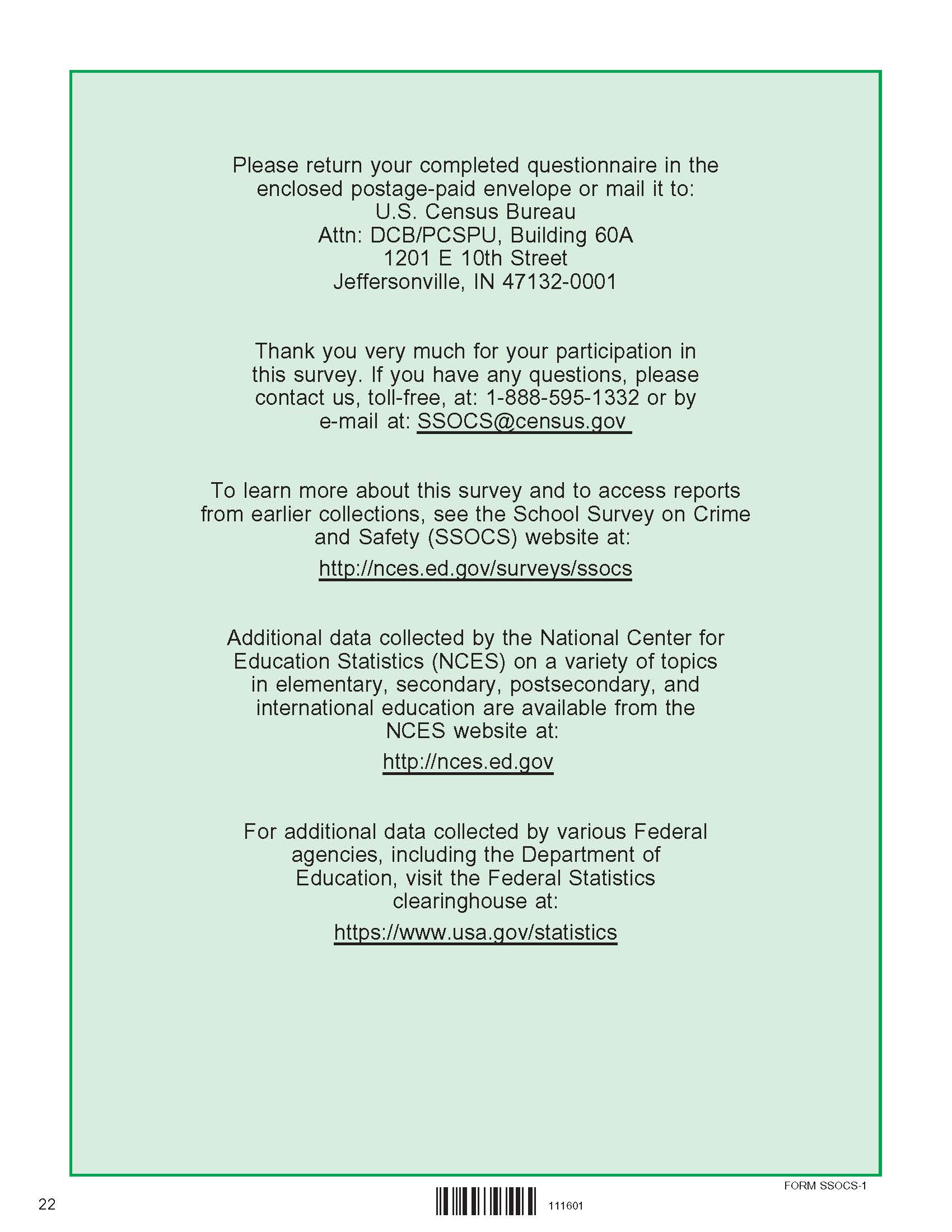
2022 SSOCS Endorsements (Placeholder from SSOCS 2020 – awaiting final list)
American Association of School Administrators

American Federation of Teachers

American School Counselors Association

Association for Middle Level Education
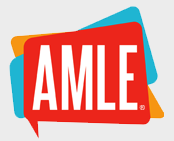
Association of American Educators
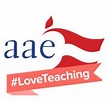
Council
of Chief State School Officers
Education Northwest

National Association of Elementary School Principals

National Association of School Psychologists
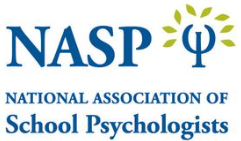
National Association of School Resource Officers

National Association of Secondary School Principals

National Association of State Boards of Education
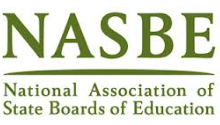
National Education Association

National Parent Teacher Association

School Safety Advocacy Council
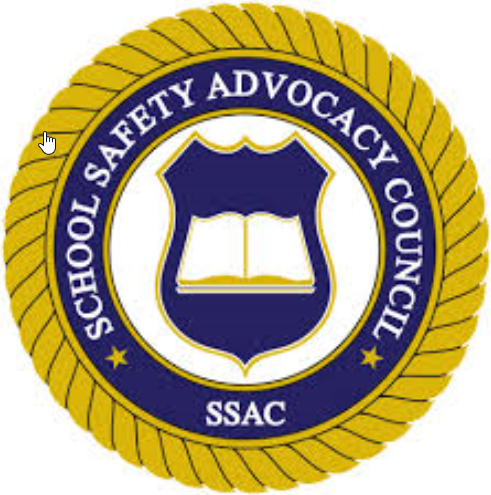
School Social Work Association of America

2022 SSOCS Incentive Handout (handout will be half-sheet)
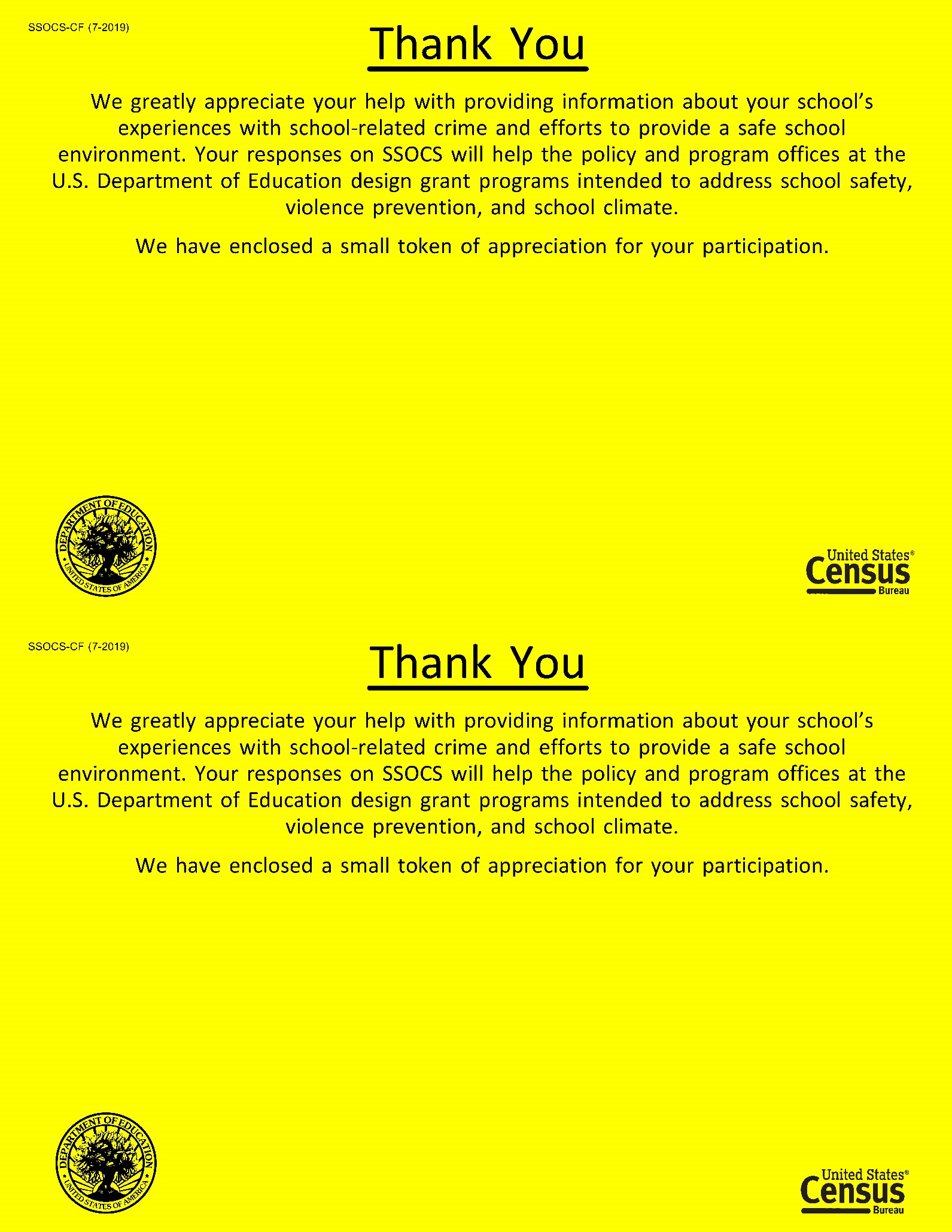
2022 Advance Letter to District Superintendent (02/10/22)
SSOCS-10L
Dear SUPERINTENDENT:
The National Center for Education Statistics (NCES) of the U.S. Department of Education is conducting
the only regular national study about crime and safety in public schools.
The School Survey on Crime and Safety (SSOCS) was previously conducted in the 1999–2000,
2003–04, 2005–06, 2007–08, 2009–10, 2015–16, 2017–18, and 2019–20 school years, which allows study of change over time. It collects information on the incidence, frequency, and nature of unsafe behaviors affecting students and school personnel, as well as school characteristics associated with school crime.
At least one school in your district has been selected to participate in SSOCS. Enclosed are materials pertaining to the survey for your reference; you do not need to take any action. Each school will receive a letter asking them to participate, list of endorsements, and brochure describing the survey.
Participating in SSOCS may create apprehension of sharing school information related to crime. Please
be assured that by federal mandate we are required to protect the responses of all schools included in
our survey. Individual responses will be combined with those from other participants to produce
summary statistics and reports only.
With your district’s participation, we can provide data to state and federal agencies about various types
of crime and discipline in schools. These data inform policy and funding used to make schools safer.
Though SSOCS is voluntary, we ask principals of all sampled schools to complete the survey, as a way
of providing an accurate picture of the diversity in our nation’s schools.
Thank you for your consideration. We hope that you will encourage the selected school(s) in your district
to participate. If you have any questions about the study, please contact the U.S. Census Bureau, the
survey collection agency, at 1–888–595–1332 or email at [email protected]. To learn more about
SSOCS, please visit http://www.nces.ed.gov/surveys/ssocs.
Sincerely,
Chris Chapman
Associate Commissioner
National Center for Education Statistics
U.S. Department of Education
Enclosures
Brochure
2022 SSOCS Questionnaire
Endorsements
NCES is authorized to conduct this survey by the Education Sciences Reform Act of 2002 (ESRA 2002, 20 U.S.C. §9543). All of the information schools provide may be used only for statistical purposes and may not be disclosed, or used, in identifiable form for any other purpose except as required by law (20 U.S.C. §9573 and 6 U.S.C. §151). Reports of the findings from the survey will not identify participating districts, schools, or staff. Individual responses will be combined with those from other participants to produce summary statistics and reports.
2022 Advance Letter to Chief State School Officer (02/10/22)
SSOCS-11L
Dear <insert name>:
The National Center for Education Statistics (NCES) of the U.S. Department of Education is conducting
the only regular national study about crime and safety in public schools.
The School Survey on Crime and Safety (SSOCS) was previously conducted in the 1999–2000,
2003–04, 2005–06, 2007–08, 2009–10, 2015–16, 2017–18, and 2019-20 school years, which allows study of change over time. It collects information on the incidence, frequency, and nature of unsafe behaviors affecting students and school personnel, as well as school characteristics associated with school crime.
At least one school in your state has been selected to participate in SSOCS. Enclosed are materials
pertaining to the survey for your reference; you do not need to take any action. Each school will receive
a letter asking them to participate, a list of endorsements, and brochure describing the survey.
Participating in SSOCS may create apprehension of sharing school information related to crime. Please
be assured that reports of the findings from the survey will not identify schools by name. Individual
responses will be combined with those from other participants to produce summary statistics and
reports only.
With your state’s participation, we can provide data to state and federal agencies about various types
of crime and discipline in schools. This data informs policy and funding used to make schools safer.
Though SSOCS is voluntary, we ask principals of all sampled schools to complete the survey, as a way
of providing an accurate picture of the diversity in our nation’s schools.
Thank you for your assistance. We hope that you will encourage districts within your state to participate.
If you have any questions about the study, please contact the U.S. Census Bureau, the survey collection
agency, at 1–888–595–1332 or email at [email protected]. To learn more about SSOCS, please visit http://www.nces.ed.gov/surveys/ssocs.
Sincerely,
Chris Chapman
Associate Commissioner
National Center for Education Statistics
U.S. Department of Education
Enclosures
2022 SSOCS Questionnaire
Endorsements
Brochure
NCES is authorized to conduct this survey by the Education Sciences Reform Act of 2002 (ESRA 2002, 20 U.S.C. §9543). All of the information schools provide may be used only for statistical purposes and may not be disclosed, or used, in identifiable form for any other purpose except as required by law (20 U.S.C. §9573 and 6 U.S.C. §151). Reports of the findings from the survey will not identify participating districts, schools, or staff. Individual responses will be combined with those from other participants to produce summary statistics and reports.
2022 Initial Letter to Principal - No Incentive, No E-mail (02/15/22)
SSOCS-13L(W)
We at the National Center for Education Statistics (NCES) within the U.S. Department of Education, need
your help by completing the 2022 School Survey on Crime and Safety (SSOCS). SSOCS is the only
national recurring survey that focuses on the frequency of crime and violence in public schools and the
programs and practices developed to provide a safe school environment.
The COVID-19 pandemic is an unprecedented moment in history that has affected how schools keep students and staff safe. In response to the pandemic, Congress approved various relief packages to assist schools with implementing safety measures and getting the equipment needed to safely open back up for in-school instruction. However, to provide evidence for the need for continued funds, we need accurate data to show where schools need the most help. Therefore, we need your help by responding to the 2022 SSOCS.
Your survey responses will be collected on a secure website. Please complete the survey online within two
weeks.

Respond now at https://respond.census.gov/ssocs
Log in using this User ID: <USERID>
Please be assured that reports of the findings from the survey will not identify schools by name. Individual responses will be combined with those from other participants to produce summary statistics and reports. For more information regarding SSOCS, please refer to the Frequently Asked Questions on the back of this letter,
enclosed brochure, and list of endorsers.
If you have any general questions about the study, contact the U.S. Census Bureau, the survey collection agency, at 1–888–595–1332 or via e-mail at [email protected]. To learn more about SSOCS, visit http://www.nces.ed.gov/surveys/ssocs.
We look forward to your school’s participation in this important data collection effort.
Sincerely,
Chris Chapman
Associate Commissioner
National Center for Education Statistics
U.S. Department of Education
Enclosures
Brochure
Endorsements
NCES is authorized to conduct this survey by the Education Sciences Reform Act of 2002 (ESRA 2002, 20 U.S.C. §9543). All of the information you provide may be used only for statistical purposes and may not be disclosed, or used, in identifiable form for any other purpose except as required by law (20 U.S.C. §9573 and 6 U.S.C. §151). Reports of the findings from the survey will not identify participating districts, schools, or staff. Individual responses will be combined with those from other participants to produce summary statistics and reports.
2022 Initial Letter to Principal - No Incentive, E-mail (02/15/22)
SSOCS-13L(WE)
Dear <insert name>:
We at the National Center for Education Statistics (NCES) within the U.S. Department of Education, need your
help by completing the 2022 School Survey on Crime and Safety (SSOCS). SSOCS is the only national recurring
survey that focuses on the frequency of crime and violence in public schools and the programs and practices
developed to provide a safe school environment.
The COVID-19 pandemic is an unprecedented moment in history that has affected how schools keep students and staff safe. In response to the pandemic, Congress approved various relief packages to assist schools with implementing safety measures and getting the equipment needed to safely open back up for in-school instruction. However, to provide evidence for the need for continued funds, we need accurate data to show where schools need the most help. Therefore, we need your help by responding to the 2022 SSOCS.
Your survey responses will be collected on a secure website. Please complete the survey online within two weeks.

Respond now at https://respond.census.gov/ssocs
Log in using this User ID: <USERID>
For your convenience, the Internet link to the survey, as well as your User ID, will be sent to you via e-mail at the following address: <address>
Please be assured that reports of the findings from the survey will not identify schools by name. Individual responses will be combined with those from other participants to produce summary statistics and reports. For more information regarding SSOCS, please refer to the Frequently Asked Questions on the back of this letter, enclosed brochure, and list of endorsers.
If you have any general questions about the study, contact the U.S. Census Bureau, the survey collection agency, at 1–888–595–1332 or via e-mail at [email protected]. To learn more about SSOCS, visit http://www.nces.ed.gov/surveys/ssocs.
We look forward to your school’s participation in this important data collection effort.
Sincerely,
Chris Chapman
Associate Commissioner
National Center for Education Statistics
U.S. Department of Education
Enclosures
Brochure
Endorsements
NCES is authorized to conduct this survey by the Education Sciences Reform Act of 2002 (ESRA 2002, 20 U.S.C. §9543). All of the information you provide may be used only for statistical purposes and may not be disclosed, or used, in identifiable form for any other purpose except as required by law (20 U.S.C. §9573 and 6 U.S.C. §151). Reports of the findings from the survey will not identify participating districts, schools, or staff. Individual responses will be combined with those from other participants to produce summary statistics and reports.
2022 Initial Letter to Principal - Incentive, No E-mail (02/15/22)
SSOCS-13L(WI)
Dear <insert name>:
We at the National Center for Education Statistics (NCES) within the U.S. Department of Education, need
your help by completing the 2022 School Survey on Crime and Safety (SSOCS). SSOCS is the only
national recurring survey that focuses on the frequency of crime and violence in public schools and the
programs and practices developed to provide a safe school environment. Please accept the enclosed
token of our appreciation for your participation in the SSOCS.
The COVID-19 pandemic is an unprecedented moment in history that has affected how schools keep students and staff safe. In response to the pandemic, Congress approved various relief packages to assist schools with implementing safety measures and getting the equipment needed to safely open back up for in-school instruction. However, to provide evidence for the need for continued funds, we need accurate data to show where schools need the most help. Therefore, we need your help by responding to the 2022 SSOCS.
Your survey responses will be collected on a secure website. Please complete the survey online within two weeks.

Respond now at https://respond.census.gov/ssocs
Log in using this User ID: <USERID>
Please be assured that reports of the findings from the survey will not identify schools by name. Individual responses will be combined with those from other participants to produce summary statistics and reports. For more information regarding SSOCS, please refer to the Frequently Asked Questions on the back of this letter,
enclosed brochure, and list of endorsers.
If you have any general questions about the study, contact the U.S. Census Bureau, the survey collection agency, at 1–888–595–1332 or via e-mail at [email protected]. To learn more about SSOCS, visit http://www.nces.ed.gov/surveys/ssocs.
We look forward to your school’s participation in this important data collection effort.
Sincerely,
Chris Chapman
Associate Commissioner
National Center for Education Statistics
U.S. Department of Education
Enclosures
Brochure
Endorsements
NCES is authorized to conduct this survey by the Education Sciences Reform Act of 2002 (ESRA 2002, 20 U.S.C. §9543). All of the information you provide may be used only for statistical purposes and may not be disclosed, or used, in identifiable form for any other purpose except as required by law (20 U.S.C. §9573 and 6 U.S.C. §151). Reports of the findings from the survey will not identify participating districts, schools, or staff. Individual responses will be combined with those from other participants to produce summary statistics and reports.
2022 Initial Letter to Principal - Incentive, E-mail (02/15/22)
SSOCS-13L(WIE)
Dear <insert name>:
We at the National Center for Education Statistics (NCES) within the U.S. Department of Education, need your
help by completing the 2022 School Survey on Crime and Safety (SSOCS). SSOCS is the only national recurring
survey that focuses on the frequency of crime and violence in public schools and the programs and practices
developed to provide a safe school environment. Please accept the enclosed token of our appreciation for
your participation in the SSOCS.
The COVID-19 pandemic is an unprecedented moment in history that has affected how schools keep students and staff safe. In response to the pandemic, Congress approved various relief packages to assist schools with implementing safety measures and getting the equipment needed to safely open back up for in-school instruction. However, to provide evidence for the need for continued funds, we need accurate data to show where schools need the most help. Therefore, we need your help by responding to the 2022 SSOCS.
Your survey responses will be collected on a secure website. Please complete the survey online within two weeks.

Respond now at https://respond.census.gov/ssocs
Log in using this User ID: <USERID>
For your convenience, the Internet link to the survey, as well as your User ID, will be sent to you via e-mail at the following address: <address>:
Please be assured that reports of the findings from the survey will not identify schools by name. Individual responses will be combined with those from other participants to produce summary statistics and reports. For more information regarding SSOCS, please refer to the Frequently Asked Questions on the back of this letter, enclosed brochure, and list of endorsers.
If you have any general questions about the study, contact the U.S. Census Bureau, the survey collection agency, at 1–888–595–1332 or via e-mail at [email protected]. To learn more about SSOCS, visit http://www.nces.ed.gov/surveys/ssocs.
We look forward to your school’s participation in this important data collection effort.
Sincerely,
Chris Chapman
Associate Commissioner
National Center for Education Statistics
U.S. Department of Education
Enclosures
Brochure
Endorsements
NCES is authorized to conduct this survey by the Education Sciences Reform Act of 2002 (ESRA 2002, 20 U.S.C. §9543). All of the information you provide may be used only for statistical purposes and may not be disclosed, or used, in identifiable form for any other purpose except as required by law (20 U.S.C. §9573 and 6 U.S.C. §151). Reports of the findings from the survey will not identify participating districts, schools, or staff. Individual responses will be combined with those from other participants to produce summary statistics and reports.
2022 Special District Approval Notice
SSOCS-13
Dear School Principal:
We know that your school district requires that researchers obtain approval to conduct surveys. The National Center for Education Statistics (NCES) of the U.S. Department of Education completed the application process and received permission to conduct the School Survey on Crime and Safety (SSOCS) in your district. If you have any questions, please contact your district or the U.S. Census Bureau, the survey collection agency, at 1–888–595–1332 or [email protected].
I would like to thank you in advance for your help in completing this survey.
Sincerely,
Chris Chapman
Associate Commissioner
National Center for Education Statistics
U.S. Department of Education
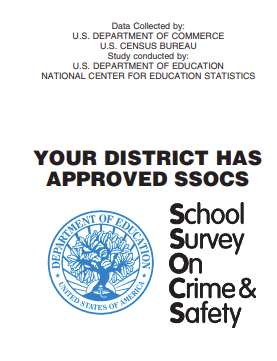
2022 First Reminder Letter to Principal; 2nd Package – All treatments (03/08/22)
SSOCS-14L(W)
Dear <insert name>:
As of today, we have not received your completed School Survey on Crime and Safety (SSOCS). If you recently completed the online questionnaire, thank you for your participation. If you have not yet completed the questionnaire, I encourage you to do so.
Your survey responses can be collected on the secure website listed below.

Respond now at https://respond.census.gov/ssocs
Log in using this User ID: <USERID>
SSOCS is the only national study that collects information about crime and safety in public schools. Findings from the 2019–20 survey indicated:
About 52 percent of schools had a written plan for procedures in the event of a pandemic disease.
A higher percentage of schools located in towns reported at least one incident of theft at school than did schools located in cities, suburbs, and rural areas.
We know that you are very busy and receive many survey requests. However, we urge you to take time to complete this very important survey. While your decision to participate is voluntary, your response is crucial to understand the state of crime and safety issues in U.S. schools. Schools will not be identified by name in any reports.
If you have any general questions about the study, contact the U.S. Census Bureau, the survey collection agency, at 1–888–595–1332 or via e-mail at [email protected]. To learn more about SSOCS, visit http://www.nces.ed.gov/surveys/ssocs.
Sincerely,
Chris Chapman
Associate Commissioner
National Center for Education Statistics
U.S. Department of Education
NCES is authorized to conduct this survey by the Education Sciences Reform Act of 2002 (ESRA 2002, 20 U.S.C. §9543). All of the information you provide may be used only for statistical purposes and may not be disclosed, or used, in identifiable form for any other purpose except as required by law (20 U.S.C. §9573 and 6 U.S.C. §151). Reports of the findings from the survey will not identify participating districts, schools, or staff. Individual responses will be combined with those from other participants to produce summary statistics and reports.
2022 Second Reminder Letter to Principal: 3rd Package, First Questionnaire
(03/28/22)
SSOCS: 2022 – 15LC
Dear <insert name>:
We recently sent you an invitation to complete the School Survey on Crime and Safety (SSOCS) online. SSOCS is the only national study that collects information about crime and safety in public schools.
According to our records, you have not yet completed the SSOCS questionnaire online. If you have recently completed the online questionnaire, thank you for your participation, and please disregard this letter. If you have not, I encourage you to complete the enclosed questionnaire or go to the link below to access the questionnaire online. We have extended the deadline to <insert date>.
Your survey responses can be collected on the secure website listed below.

Respond now at https://respond.census.gov/ssocs
Log in using this User ID: <USERID>
Although your decision to participate is voluntary, your response is crucial to understand the overall state of school crime and safety issues in U.S. schools. Data from previous SSOCS collections are used by the Department of Education’s Office of Safe and Supportive Schools to inform decisions for guidance to states and local education agencies pertinent to providing a safe school environment for students. Specifically, SSOCS asks about schools’ implementation of safety measures in response to pandemic disease. Having accurate information on this helps to inform the need for more resources to provide to states during unprecedented times, such as the COVID-19 pandemic of 2020. As a reminder, schools will not be identified by name in any reports.
A postage-paid return envelope is enclosed for your convenience. If you have any questions about the study, please do not hesitate to contact the U.S. Census Bureau at 1–888–595–1332. If you have any general questions about the study, contact the U.S. Census Bureau, the survey collection agency, at 1-888-595-1332, or via e-mail at [email protected]. To learn more about the SSOCS, please visit http://www.nces.ed.gov/surveys/ssocs.
Sincerely,
Chris Chapman
Associate Commissioner
National Center for Education Statistics
U.S. Department of Education
Enclosures
2022 SSOCS Questionnaire
NCES is authorized to conduct this survey by the Education Sciences Reform Act of 2002 (ESRA 2002, 20 U.S.C. §9543). All of the information you provide may be used only for statistical purposes and may not be disclosed, or used, in identifiable form for any other purpose except as required by law (20 U.S.C. §9573 and 6 U.S.C. §151). Reports of the findings from the survey will not identify participating districts, schools, or staff. Individual responses will be combined with those from other participants to produce summary statistics and reports.
2022 Third Reminder Letter to Principal; 4th Package, Second Questionnaire (04/28/22)
SSOCS-16L
Dear <insert name>:
Over the past two months, we have contacted you to ask for your participation in the 2022 School Survey on Crime and Safety (SSOCS). If you have already returned the completed questionnaire, thank you for your participation, and please disregard this letter. If you have not yet had the opportunity to complete the questionnaire, I encourage you to complete the enclosed questionnaire as soon as possible.
Your survey responses can also be collected on the secure website listed below.
Respond
now at https://respond.census.gov/ssocs
Log
in using this User ID: <USERID>
We know that you are very busy and receive many survey requests. However, we urge you to take time to complete this very important survey. While your decision to participate is voluntary, your response is crucial to understand the state of crime and safety issues in U.S. schools. Schools will not be identified by name in any reports. Your responses help the policy and program offices at the U.S. Department of Education design grant programs intended to address school safety, violence prevention, and school climate.
A postage-paid return envelope is enclosed for your convenience. If you have any questions about the study, please do not hesitate to contact the U.S. Census Bureau at 1–888–595–1332. The U.S. Census Bureau, the survey collection agency, is also available to answer your questions via e-mail at [email protected]. To learn more about SSOCS, please visit http://www.nces.ed.gov/surveys/ssocs.
Sincerely,
Chris Chapman
Associate Commissioner
National Center for Education Statistics
U.S. Department of Education
Enclosures
2022 SSOCS Questionnaire
NCES is authorized to conduct this survey by the Education Sciences Reform Act of 2002 (ESRA 2002, 20 U.S.C. §9543). All of the information you provide may be used only for statistical purposes and may not be disclosed, or used, in identifiable form for any other purpose except as required by law (20 U.S.C. §9573 and 6 U.S.C. §151). Reports of the findings from the survey will not identify participating districts, schools, or staff. Individual responses will be combined with those from other participants to produce summary statistics and reports.
2022 Initial E-mail to Principal – “Email-First” Before Treatment Group
SSOCS-P1A
Subject: U.S. Department of Education Survey!
Dear <PRINCIPAL>:
<SCHNAM>
We at the National Center for Education Statistics (NCES) within the U.S. Department of Education, need your help by completing the 2022 School Survey on Crime and Safety (SSOCS). SSOCS is the only national recurring survey that focuses on the frequency of crime and violence in public schools and the programs and practices developed to provide a safe school environment.
The COVID-19 pandemic is an unprecedented moment in history that has affected how schools keep students and staff safe. In response to the pandemic, Congress approved various relief packages to assist schools with implementing safety measures and getting the equipment needed to safely open back up for in-school instruction. The Department of Education relies on studies including SSOCS to help determine how to allocate funds. Your school is one of a small number of schools selected to represent the needs of many other schools. Your response is critical to ensuring that we have accurate data to base these decisions on. Therefore, we need your help by responding to the 2022 SSOCS. We will be sending you a package at the school listed above with more information about the SSOCS<< and $10 as a token of our appreciation>>.
Your survey responses will be collected on a secure website. Please take time now to complete the SSOCS.
Respond now at https://respond.census.gov/ssocs
Log in using this User ID: <USERID>
Please be assured that reports of the findings from the survey will not identify schools by name. Individual responses will be combined with those from other participants to produce summary statistics and reports.
If you have any general questions about the study, contact the U.S. Census Bureau, the survey collection agency, at 1–888–595–1332 or via e-mail at [email protected]. To learn more about SSOCS, visit http://www.nces.ed.gov/surveys/ssocs.
We look forward to your school’s participation in this important data collection effort.
Sincerely,
Chris Chapman
Associate Commissioner
National Center for Education Statistics
U.S. Department of Education
2022 Initial E-mail to Principal – After Treatment / Control Group
SSOCS-P1B
Subject line: U.S. Department of Education Survey!
Dear <PRINCIPAL>:
<SCHNAM>
We at the National Center for Education Statistics (NCES) within the U.S. Department of Education, need your help by completing the 2022 School Survey on Crime and Safety (SSOCS). SSOCS is the only national recurring survey that focuses on the frequency of crime and violence in public schools and the programs and practices developed to provide a safe school environment.
The COVID-19 pandemic is an unprecedented moment in history that has affected how schools keep students and staff safe. In response to the pandemic, Congress approved various relief packages to assist schools with implementing safety measures and getting the equipment needed to safely open back up for in-school instruction. The Department of Education relies on studies including SSOCS to help determine how to allocate funds. Your school is one of a small number of schools selected to represent the needs of many other schools. Your response is critical to ensuring that we have accurate data to base these decisions on. Therefore, we need your help by responding to the 2022 SSOCS. We recently sent you a package at the school listed above with more information about the SSOCS<< and $10 as a token of our appreciation>>.
Your survey responses will be collected on a secure website. Please take time now to complete the SSOCS.
Respond now at https://respond.census.gov/ssocs
Log in using this User ID: <USERID>
Please be assured that reports of the findings from the survey will not identify schools by name. Individual responses will be combined with those from other participants to produce summary statistics and reports.
If you have any general questions about the study, contact the U.S. Census Bureau, the survey collection agency, at 1–888–595–1332 or via e-mail at [email protected]. To learn more about SSOCS, visit http://www.nces.ed.gov/surveys/ssocs.
We look forward to your school’s participation in this important data collection effort.
Sincerely,
Chris Chapman
Associate Commissioner
National Center for Education Statistics
U.S. Department of Education
2022 First reminder e-mail to principals – All Treatments (03/15/22)
Subject line: U.S. Department of Education Survey Reminder
Dear <PRINCIPAL>:
We need your help completing the 2022 School Survey on Crime and Safety (SSOCS), to gather statistics on the prevalence of programs and practices implemented to provide a safe school environment. Findings from the 2019–20 SSOCS indicated that 94 percent of all public schools reported having activities for students that included social emotional learning. We know social emotional learning is an important aspect of providing a safe environment in schools, therefore it is imperative to continue to collect updated information on this topic, as well as other similar topics.
If you have already logged in and completed your questionnaire, thank you very much for your participation. If not, I encourage you to take the time to do so. Your survey responses will be collected on a secure website.
Respond now at https://respond.census.gov/ssocs
Log in using this User ID: <USERID>
The success of this national survey depends on your participation. Only a small percentage of principals are selected to participate. We cannot substitute another principal for you. Please note that reports of the findings from the survey will not identify schools by name. Individual responses will be combined with those from other participants to produce summary statistics and reports.
If you have any general questions about the study, please contact the U.S. Census Bureau, the survey collection agency, at 1–888–595–1332 or via e-mail at [email protected]. To learn more about SSOCS, visit http://www.nces.ed.gov/surveys/ssocs.
Sincerely,
Chris Chapman
Associate Commissioner
National Center for Education Statistics
U.S. Department of Education
2022 Second reminder E-mail – All Treatments (04/05/22)
Subject
line: U.S. Department of Education Survey
Reminder
Dear <PRINCIPAL>:
Your school was selected to participate in the School Survey on Crime and Safety (SSOCS). If you have already completed the survey, thank you for your assistance and please disregard this email. If you haven’t had the opportunity to log on and complete the survey yet, we encourage you to do so. Your survey responses will be collected on a secure website.
Respond now at https://respond.census.gov/ssocs
Log in using this User ID: <USERID>
Your completed questionnaire will provide the nation accurate statistics on school crime and safety for the 2021–22 school year. Please note that reports of the findings from the survey will not identify schools by name. Individual responses will be combined with those from other participants to produce summary statistics and reports.
You may call with any questions or may complete the survey over the phone by calling the U.S. Census Bureau at 1–888–595–1332 or via e-mail at [email protected]. To learn more about SSOCS, visit http://www.nces.ed.gov/surveys/ssocs.
Sincerely,
Chris Chapman
Associate Commissioner
National Center for Education Statistics
U.S. Department of Education
2022 Third reminder e-mail – All Treatments (04/19/22)
Subject Line: Reminder! U.S. Department of Education Survey – Help Provide Information on Emergency Plans and Procedures
Dear <PRINCIPAL>:
Did you know that during the 2019–20 school year, 52 percent of all public schools reported having a written plan describing procedures to be performed in the event of a pandemic disease?
This information is collected on the School Survey on Crime and Safety (SSOCS), the only national recurring survey on the frequency of crime and violence in public schools and the programs and practices developed to provide a safe school environment. There is still time for your school to participate in the study. If you have already completed and returned your questionnaire, thank you! If not, in order for your school to be included in this study, which is used by Congress and the U.S. Department of Education program offices to determine where schools are in need of the most help with dealing with unprecedented circumstances, such as pandemics, it is critical that you respond now by clicking on the link below.
Respond now at https://respond.census.gov/ssocs
Log in using this User ID: <USERID>
Please note that reports of the findings from the survey will not identify schools by name. Individual responses will be combined with those from other participants to produce summary statistics and reports.
You may call with any questions or may complete the survey over the phone by calling the U.S. Census Bureau at 1–888–595–1332 or via e-mail at [email protected]. To learn more about SSOCS, visit http://www.nces.ed.gov/surveys/ssocs.
Sincerely,
Chris Chapman
Associate Commissioner
National Center for Education Statistics
U.S. Department of Education
2022 Fourth Reminder e-mail – All Treatments (05/05/22)
Subject Line: Reminder! U.S. Department of Education Survey
Dear <PRINCIPAL>:
Did you know that during the 2019–20 school year, about 55 percent of schools provided diagnostic mental health assessments to evaluate students for mental health disorders and 42 percent provided treatment to students for mental health disorders?
This information is collected on the School Survey on Crime and Safety (SSOCS), the only national recurring survey on the frequency of crime and violence in public schools and the programs and practices developed to provide a safe school environment. There is still time for your school to participate in the study. If you have already completed and returned your questionnaire, thank you! If not, in order for your school to be included in this study, which is used by Congress and the U.S. Department of Education program offices to determine where schools are in need of the most help for providing resources to students, such as mental health services, it is critical that you respond now by clicking on the link below.
Respond now at https://respond.census.gov/ssocs
Log in using this User ID: <USERID>
Please note that reports of the findings from the survey will not identify schools by name. Individual responses will be combined with those from other participants to produce summary statistics and reports.
You may call with any questions or may complete the survey over the phone by calling the U.S. Census Bureau at 1–888–595–1332 or via e-mail at [email protected]. To learn more about SSOCS, visit http://www.nces.ed.gov/surveys/ssocs.
Sincerely,
Chris Chapman
Associate Commissioner
National Center for Education Statistics
U.S. Department of Education
2022 Fifth Reminder e-mail – All Treatments (TBD date in late May 2022)
Subject line: We Need Your Input! U.S. Department of Education Survey Reminder
Dear <PRINCIPAL>:
We need your help by participating in this study! Your responses to the 2022 School Survey on Crime and Safety (SSOCS) help the policy and program offices at the U.S. Department of Education design grant programs intended to address school safety, violence prevention, and school climate.
If you haven’t had the opportunity to log on and complete the survey yet, we encourage you to do so now by clicking the link below. Your survey responses will be collected on a secure website.
Respond now at https://respond.census.gov/ssocs
Log in using this User ID: <USERID>
Your completed questionnaire will provide the nation accurate statistics on school crime and safety for the 2021–22 school year. Please note that reports of the findings from the survey will not identify schools by name. Individual responses will be combined with those from other participants to produce summary statistics and reports.
You may call with any questions or may complete the survey over the phone by calling the U.S. Census Bureau at 1–888–595–1332 or via email at [email protected]. To learn more about SSOCS, visit http://www.nces.ed.gov/surveys/ssocs.
Sincerely,
Chris Chapman
Associate Commissioner
National Center for Education Statistics
U.S. Department of Education
2022 Sixth Reminder e-mail – All Treatments (TBD date in early June 2022)
Subject line: There is Still Time! U.S. Department of Education Survey Reminder
Dear <PRINCIPAL>:
We need your help completing the 2022 School Survey on Crime and Safety (SSOCS), a federal survey that gathers statistics on programs and practices implemented across our nation to provide a safe school environment.
If you haven’t had the opportunity to log on and complete the survey yet, we encourage you to do so. Your survey responses will be collected on a secure website.
Respond now at https://respond.census.gov/ssocs
Log in using this User ID: <USERID>
Please note that reports of the findings from the survey will not identify schools by name. Individual responses will be combined with those from other participants to produce summary statistics and reports.
If you have any questions contact the U.S. Census Bureau, the survey collection agency, by phone at 1–888–595–1332 or via email at [email protected]. To learn more about SSOCS, visit http://www.nces.ed.gov/surveys/ssocs.
Sincerely,
Chris Chapman
Associate Commissioner
National Center for Education Statistics
U.S. Department of Education
2022 Seventh Reminder e-mail – All Treatments (TBD data in June 2022)
Subject line: We need your response today- U.S. Department of Education Survey Reminder
Dear <PRINCIPAL>:
There is still time to complete the School Survey on Crime and Safety (SSOCS). You may respond now by clicking on the link below.
Respond now at https://respond.census.gov/ssocs
Log in using this User ID: <USERID>
Your completed questionnaire will provide the nation accurate statistics of programs and policies implemented to provide a safe school environment. Please note that reports of the findings from the survey will not identify schools by name. Your survey responses will be collected on a secure website. Individual responses will be combined with those from other participants to produce summary statistics and reports.
If you have any questions contact the U.S. Census Bureau, the survey collection agency, by phone at 1–888–595–1332 or via email at [email protected]. To learn more about SSOCS, visit http://www.nces.ed.gov/surveys/ssocs.
Sincerely,
Chris Chapman
Associate Commissioner
National Center for Education Statistics
U.S. Department of Education
2022 Reminder email – All Treatments (TBD in the Spring or Summer of 2022)
Subject line: U.S. Department of Education Survey – Please respond!
Dear <PRINCIPAL>:
Data collection for the School Survey on Crime and Safety (SSOCS) is coming to a close. Don’t miss your opportunity to contribute to data that are used by the U.S. Department of Education’s policy and program offices for making policy decisions and designing grant programs intended to address school safety, violence prevention programs, and school climate.
If you have already responded to our survey, thank you! If you have not responded yet, please click on the link below
Respond now at https://respond.census.gov/ssocs
Log in using this User ID: <USERID>
Your survey responses will be collected on a secure website and schools will not be identified by name in any reports. We appreciate your help in this important data collection effort!
SSOCS is conducted by the National Center for Education Statistics (NCES) within the U.S. Department of Education and collected by the U.S. Census Bureau. If you have any general questions about the study or if you wish to complete the survey with assistance, please contact the U.S. Census Bureau at 1–888–595–1332 or via email at [email protected]. To learn more about SSOCS, visit http://www.nces.ed.gov/surveys/ssocs.
Sincerely,
Chris Chapman
Associate Commissioner
National Center for Education Statistics
U.S. Department of Education
2022 Thank You Email to Principals (August 2022)
Subject line: Thank You!
Dear <PRINCIPAL>:
The National Center for Education Statistics (NCES) of the U.S. Department of Education would like to thank you for making the 2022 School Survey on Crime and Safety (SSOCS) a success!
SSOCS is the only nationally representative survey that collects data on crime and safety from a principal’s perspective, so we appreciate you taking time out of your busy schedule to represent your school in this important effort. Overall, we were able to gather data from over <insert number> schools. Your participation was crucial in helping us achieve this success.
Please visit https://ies.ed.gov/newsflash/ and sign up to receive up-to-date alerts about a number of education topics, including crime and safety in schools. Tables and reports based on data from the 2019–20 SSOCS and earlier SSOCS administrations are available on the NCES website. In addition to these data products, tables and reports based on the 2021–22 SSOCS will be posted to our website at http://www.nces.ed.gov/surveys/ssocs upon release.
Again, thank you for your time and participation.
Sincerely,
Chris Chapman
Associate Commissioner
National Center for Education Statistics
U.S. Department of Education
2022 Letter to Principal – Replacement Questionnaire
SSOCS-17L
Dear <PRINCIPAL>:
Recently, someone in your school contacted the U.S. Census Bureau regarding the School Survey on Crime and Safety (SSOCS), a national study that collects information about crime and safety in public schools. Enclosed is the replacement questionnaire requested.
Your survey responses can also be collected on the secure website listed below.

Respond now at https://respond.census.gov/ssocs
Log in using this User ID: <USERID>
Please complete within two weeks. A postage-paid return envelope is enclosed for your convenience. If you have any general questions about the survey, please contact the U.S. Census Bureau, the survey collection agency at 1–888–595–1332 or via e-mail at [email protected]. To learn more about SSOCS, please visit http://www.nces.ed.gov/surveys/ssocs.
Sincerely,
Chris Chapman
Associate Commissioner
National Center for Education Statistics
U.S. Department of Education
Enclosures
2022 SSOCS Questionnaire
NCES is authorized to conduct this survey by the Education Sciences Reform Act of 2002 (ESRA 2002, 20 U.S.C. §9543). All of the information you provide may be used only for statistical purposes and may not be disclosed, or used, in identifiable form for any other purpose except as required by law (20 U.S.C. §9573 and 6 U.S.C. §151). Reports of the findings from the survey will not identify participating districts, schools, or staff. Individual responses will be combined with those from other participants to produce summary statistics and reports.
2022 Thank You Letter to Principal (August 2022)
SSOCS-18L
Dear <PRINCIPAL>:
The National Center for Education Statistics (NCES) of the U.S. Department of Education would like to thank you for making the 2022 School Survey on Crime and Safety (SSOCS) a success!
SSOCS is the only nationally representative survey that collects data on crime and safety from a principal’s perspective, so we appreciate you taking time out of your busy schedule to represent your school in this important effort. This school year, we were able to gather data from over <insert number> schools. Your participation was crucial in helping us achieve this success.
Please visit http://ies.ed.gov/newsflash/#nces and sign up to receive up-to-date alerts about a number of education topics, including crime and safety in schools. Tables based on data from the 2019-20 SSOCS and earlier SSOCS administrations are available on the NCES website. In addition to these data products, tables and reports based on the 2021–22 SSOCS will be posted to our website at http://www.nces.ed.gov/surveys/ssocs upon release.
Again, thank you for your time and participation.
Sincerely,
Chris Chapman
Associate Commissioner
National Center for Education Statistics
U.S. Department of Education
2022 Thank You Letter to District (August 2022)
SSOCS-18L(D)
Dear <insert name>:
The National Center for Education Statistics (NCES) of the U.S. Department of Education would like to thank you for making the 2021–22 School Survey on Crime and Safety (SSOCS) a success!
SSOCS is the only nationally representative survey that collects data on crime and safety from a principal’s perspective, so we appreciate your approval of our application to conduct research within your district. Overall, we were able to gather data from over <insert number> schools. Your approval was crucial in helping us achieve this success.
Please visit http://ies.ed.gov/newsflash/#nces and sign up to receive up-to-date alerts about a number of education topics, including crime and safety in schools. Tables based on data from the 2019-20 SSOCS and earlier SSOCS administrations are available on the NCES website. In addition to these data products, tables and reports based on the 2021–22 SSOCS will be posted to our website at http://www.nces.ed.gov/surveys/ssocs upon release.
Again, thank you for your approval.
Sincerely,
Chris Chapman
Associate Commissioner
National Center for Education Statistics
U.S. Department of Education
2022 Frequently Asked Questions (to be included on the back of initial letter to principal)
What is the SSOCS?
The School Survey on Crime and Safety (SSOCS) is a national survey of elementary and secondary public schools that collects information on school safety, including school practices related to the prevention and reduction of crime, the frequency of school crime and violence, and disciplinary actions used to handle infractions. This survey does not involve students, parents, or teachers, and does not involve any use of classroom time.
What happens if a school refuses to participate?
All participation is voluntary. There are no penalties for not participating in the study. However, each school in the SSOCS sample was selected to represent schools with similar characteristics. When a school refuses to participate, we’re unable to replace that school. This means we’ll have fewer responses which will result in less precision in our estimates and the potential to not be able to report out estimates for schools like yours. When completing the questionnaire, respondents can skip any question they do not want to answer. If you are hesitant to be a part of the study, please reach out to the 2022 SSOCS staff at 1–888–595–1332 or via e-mail at [email protected] to address any concerns you may have.
How will the names of participants and their responses be kept confidential?
Under law, all of the information provided by schools may be used only for statistical purposes and may not be disclosed, or used, in identifiable form for any other purpose except as required by law (20 U.S.C. §9573 and 6 U.S.C. §151). All staff working on the study have signed an Affidavit of Nondisclosure where they swear to abide by this law. Employees, including temporary employees, or other persons who have sworn to observe the limitations imposed by this law, who knowingly publish or communicate any individually identifiable information will be subject to fines of up to $250,000, or up to 5 years in prison, or both (Class E felony).
That sounds like governmentese. What are you really telling me?
By law, we can only use your responses for reporting crime and safety information at an aggregate level, which means we’re combining your information with those from other participating schools to produce summary statistics and reports. All staff working on the project have sworn to abide by the law to not disclose information provided by participants in the study. Check out the 2018 SSOCS First Look Report to see how the estimates are displayed at https://nces.ed.gov/pubs2019/2019061.pdf.
The letter says this is a U.S. Department of Education survey. Who is NCES and why is the Census Bureau involved?
We understand this is confusing. The National Center for Education Statistics (NCES) is the primary federal entity for collecting and analyzing data related to education in the United States. NCES is located within the U.S. Department of Education and the Institute of Education Sciences. NCES fulfills a Congressional mandate to collect, collate, analyze, and report complete statistics on the condition of education in the United States; conduct and publish reports; and review and report on education activities internationally. While NCES conducts the surveys, we partner with the U.S. Census Bureau to fulfill the data collection operations. This is why you see mailing labels, email addresses, and contact information from the Census Bureau.
Do public school and school safety organizations endorse the SSOCS?
Yes! Check out the insert in the package to see a list of public school and school safety
organizations that endorse the SSOCS.
2022 SSOCS Web Instrument Text
Item: Welcome Page
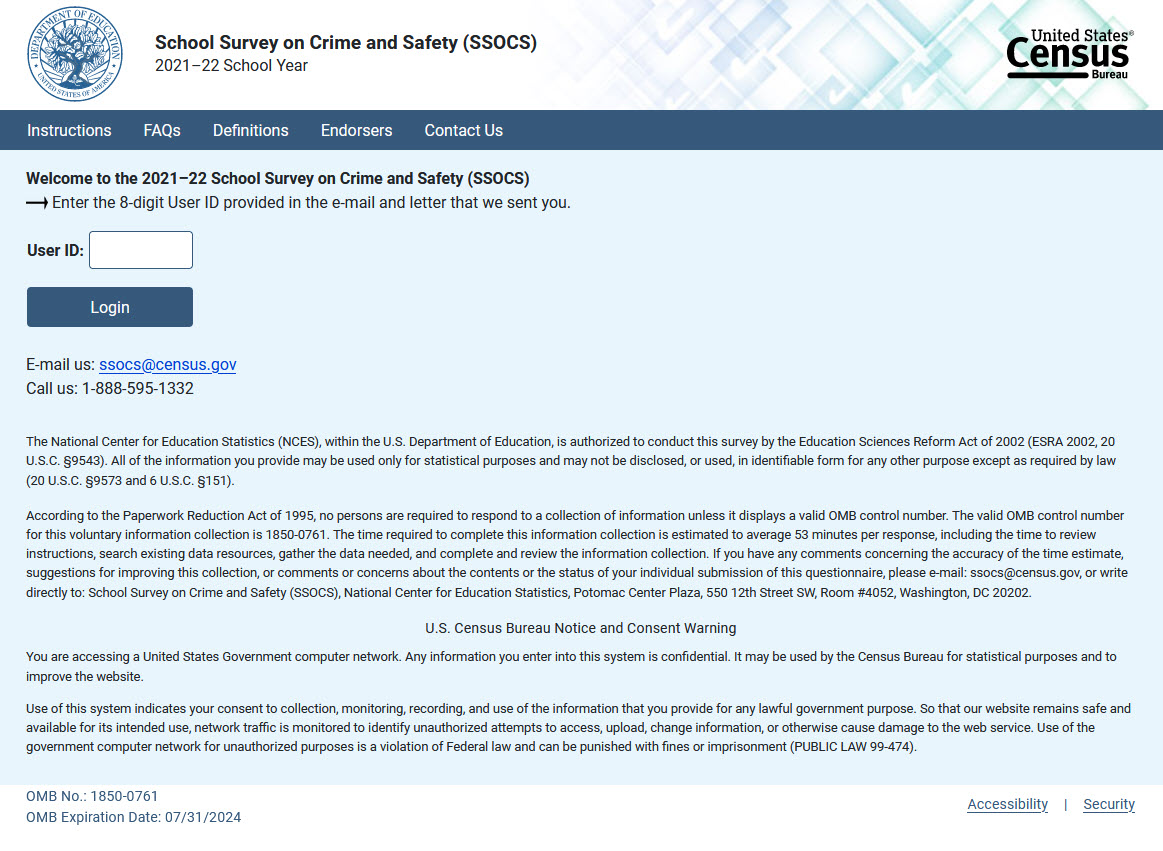
Item: PIN & Security Question:
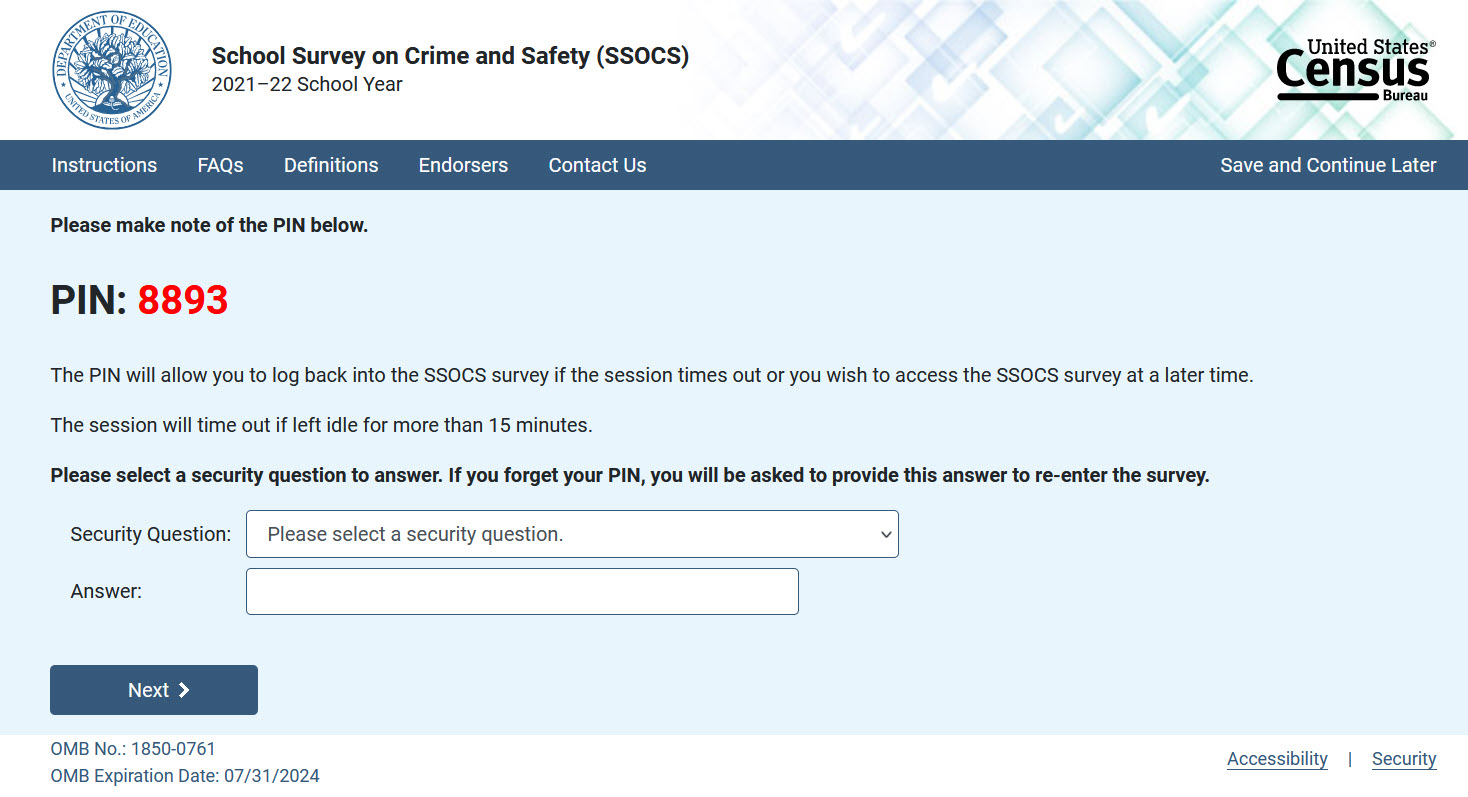
Item: PIN Reset:
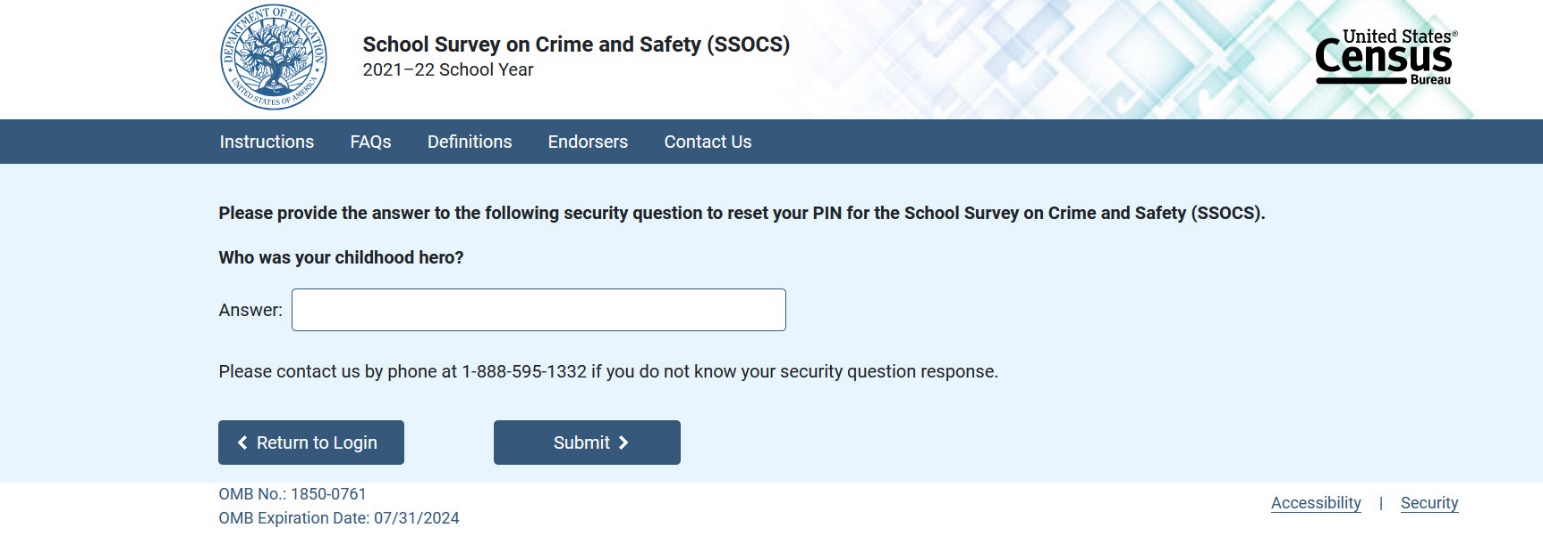
Item: New PIN:
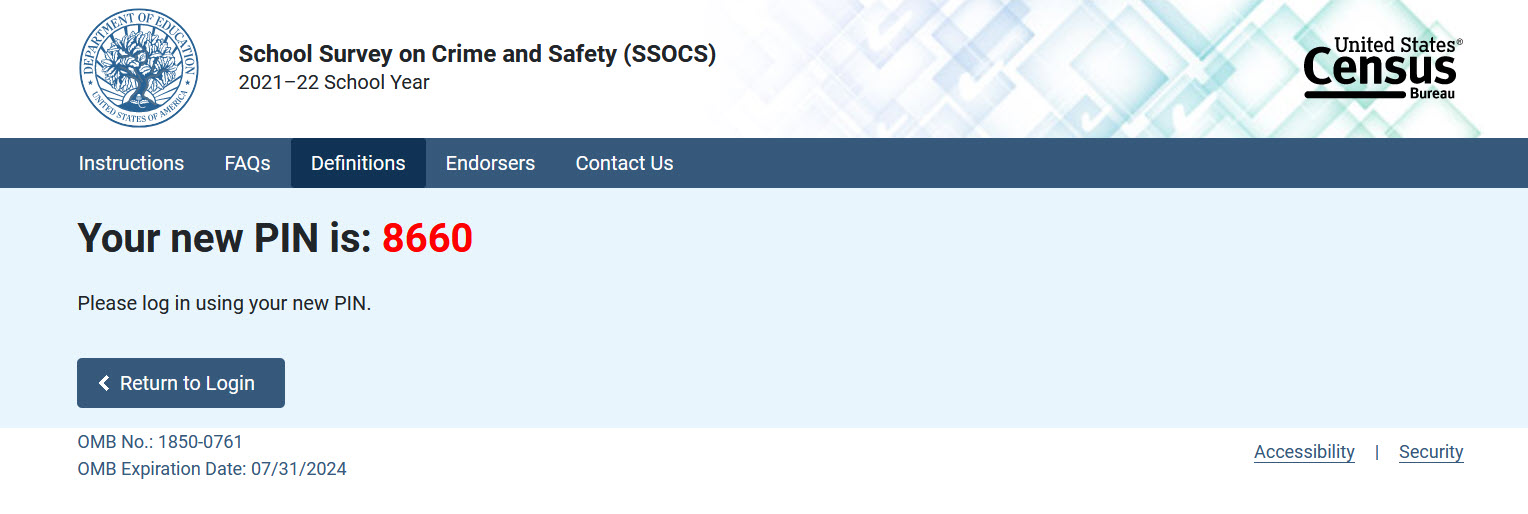
Item: Welcome page for returning users:
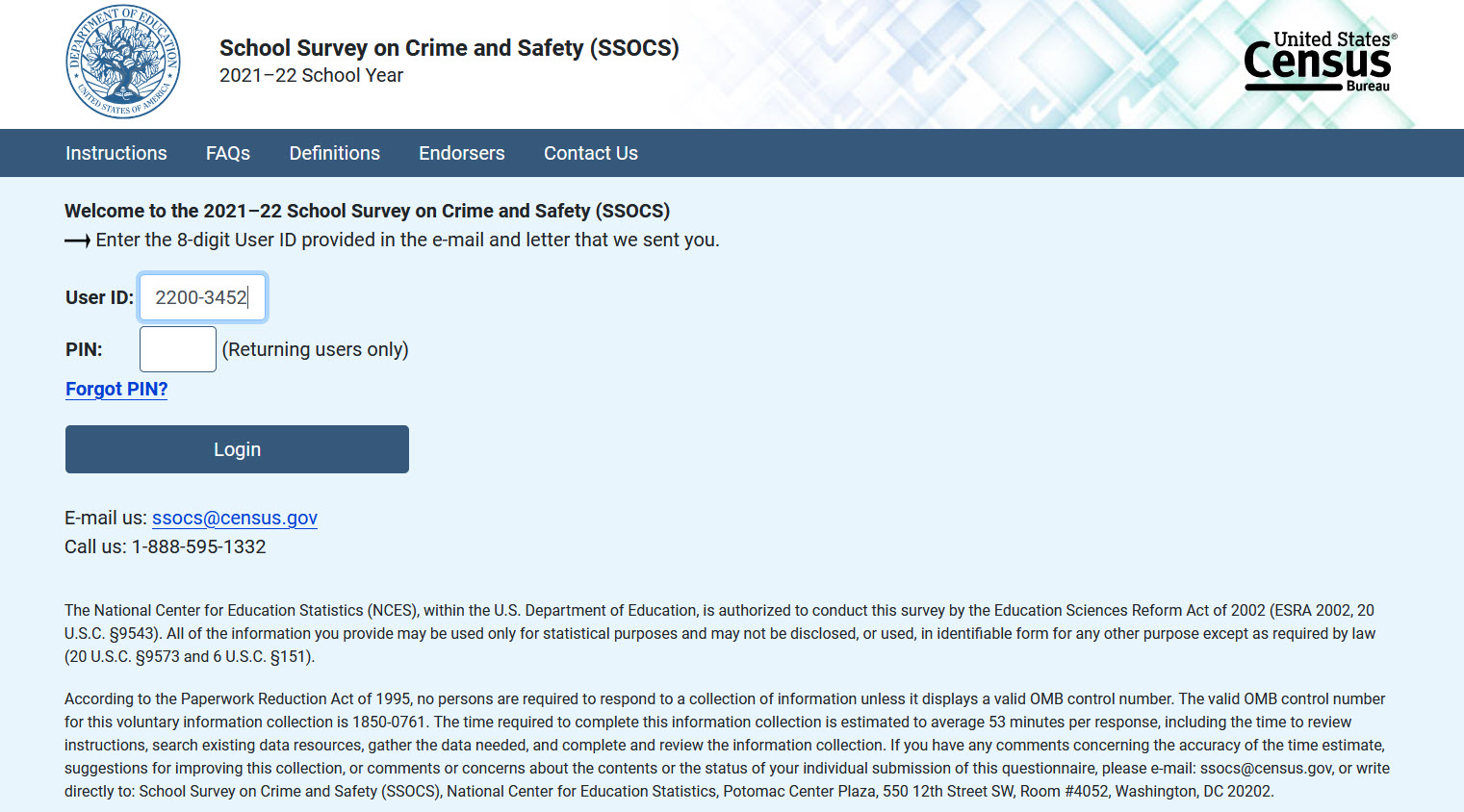
Item: Thank You Page
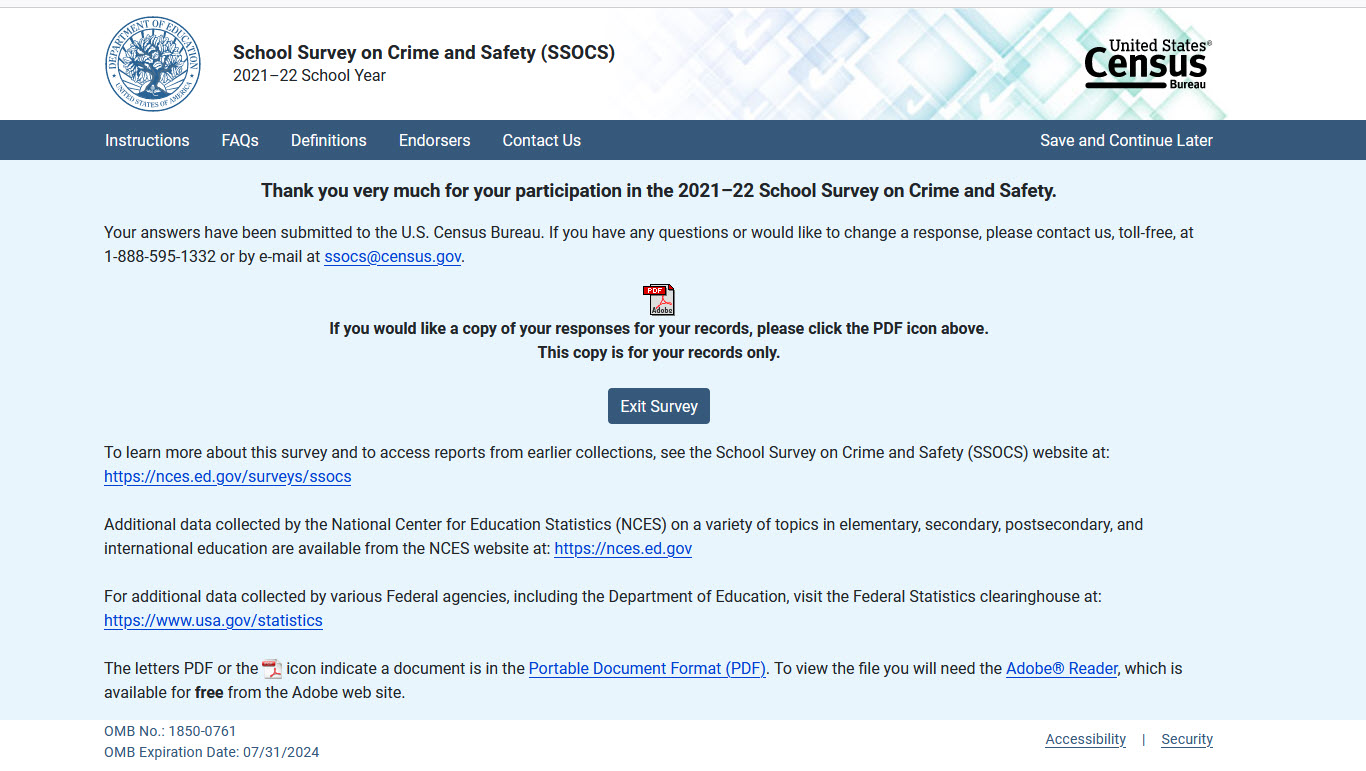
Item: Instructions Tab (instructions)
Return to Survey (button)
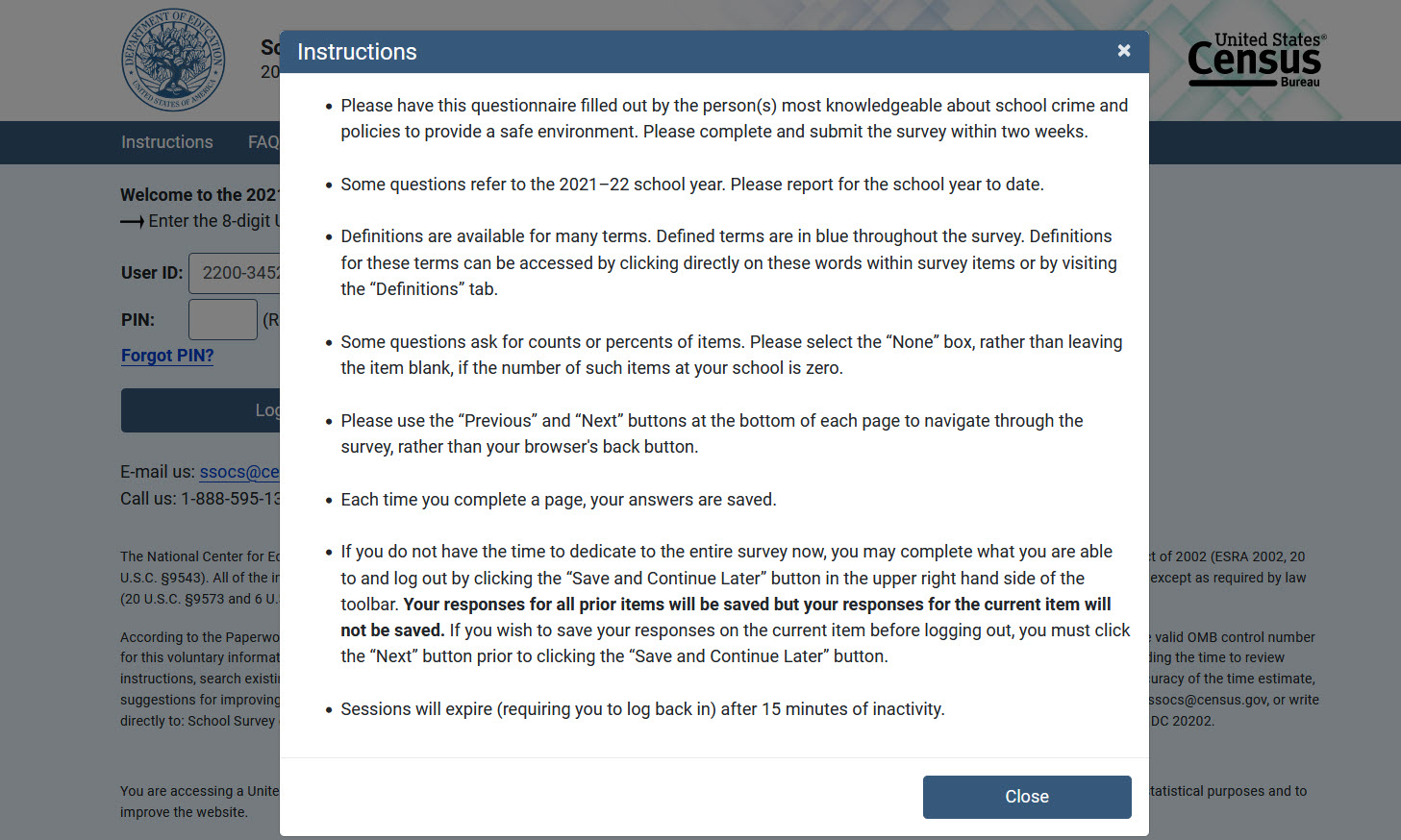
Item:
Endorsers Tab (endorsers)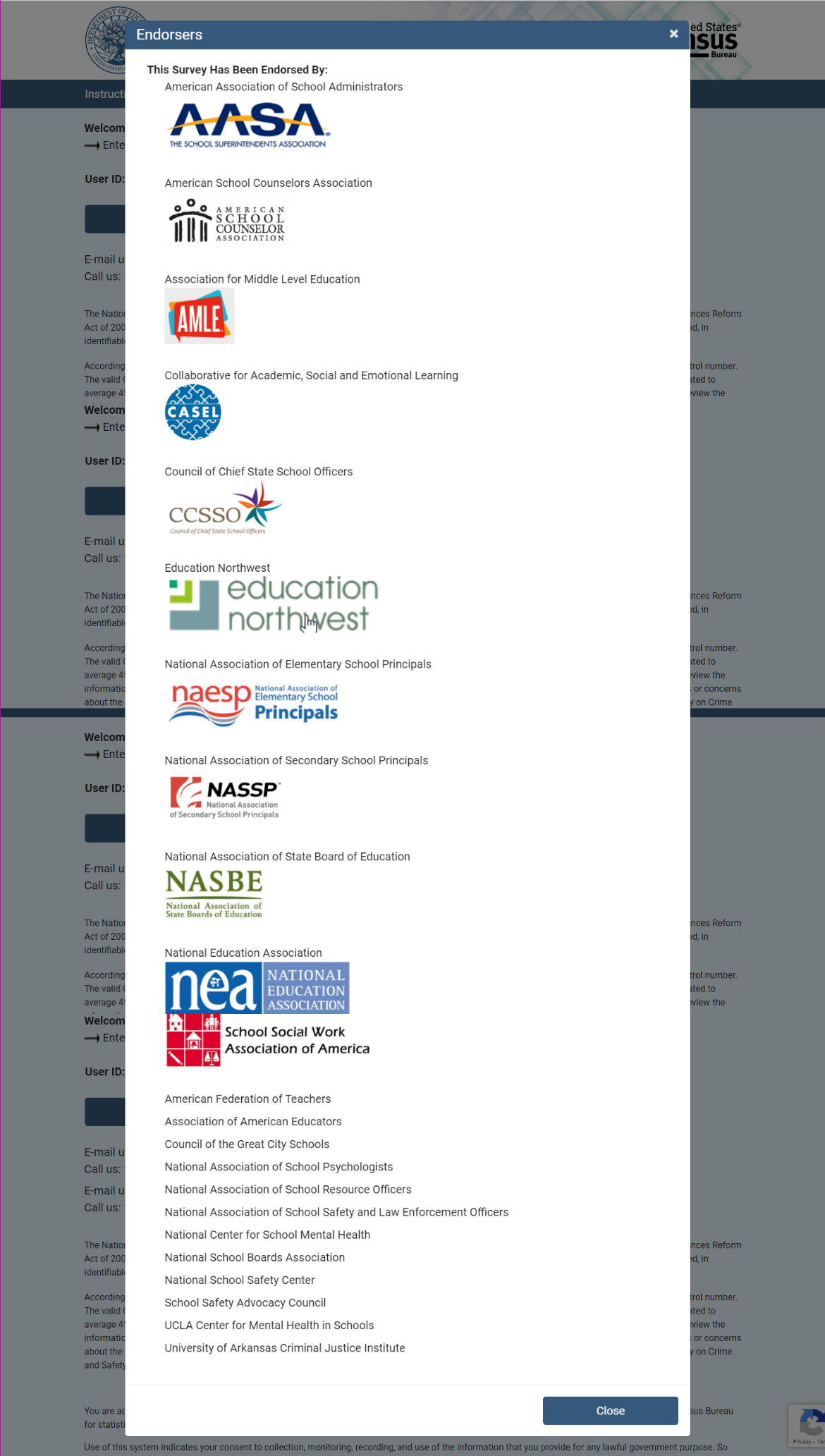
Item: FAQs Tab (pop out)
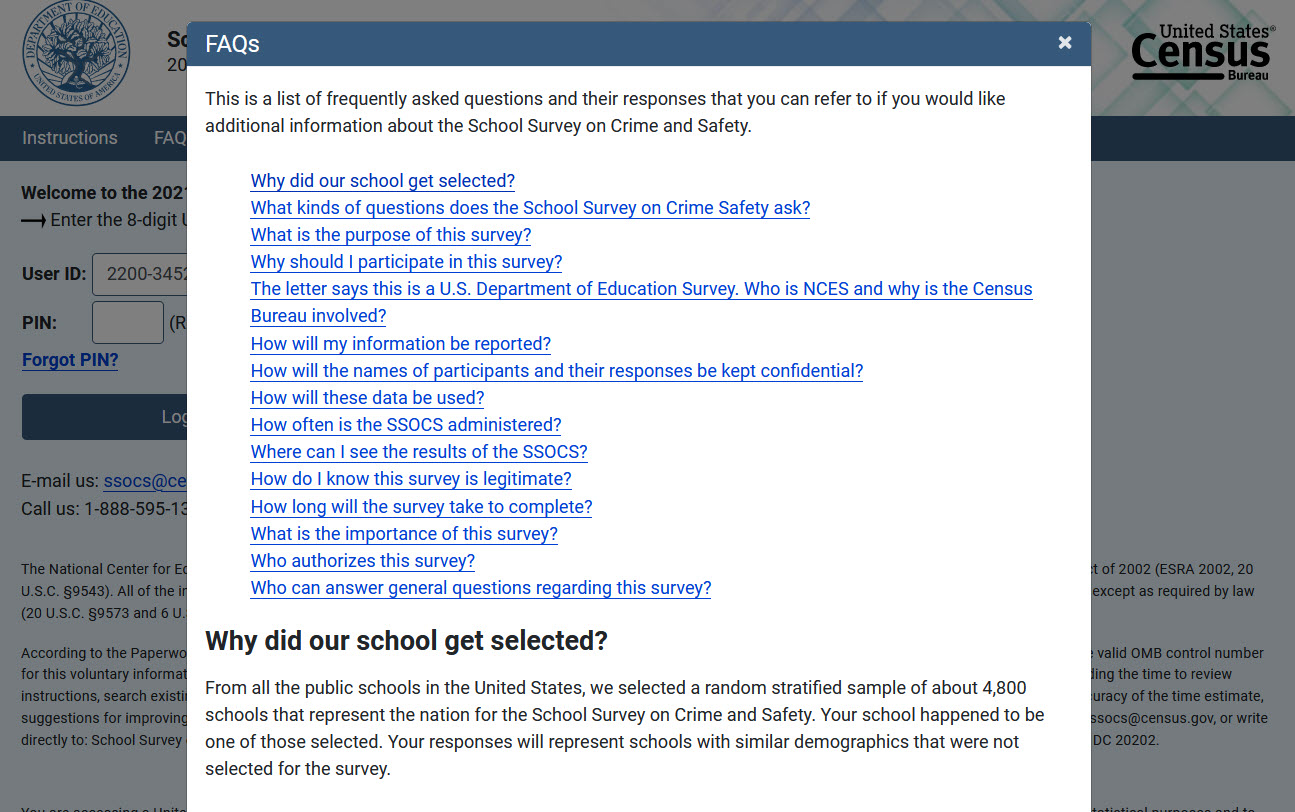
Each question is listed as a link. Move the screen down to the appropriate answer text when the user clicks on a question.
Return to Survey (button)
List the following questions as links. When clicked, display the appropriate answer text.
Why did our school get selected?
From all the public schools in the United States, we selected a random stratified sample of about 4,800 schools that represent the nation for the 2022 School Survey on Crime and Safety. Your school happened to be one of those selected. Your responses will represent schools with similar demographics that were not selected for the survey.
What kinds of questions does the School Survey on Crime & Safety ask?
Frequency and types of crimes at schools, including rape, sexual assault, attacks with or without weapons, robbery, theft, and vandalism;
Frequency and types of disciplinary actions such as removals, transfers, and suspensions for selected offenses;
Perceptions of other disciplinary problems such as bullying, verbal abuse, and disorder in the classroom;
Description of school policies and programs concerning crime and safety;
Description of the pervasiveness of student and teacher involvement in efforts that are intended to prevent or reduce school violence;
Mental health services available to students at school; and
General school characteristics.
What is the purpose of this survey?
SSOCS is the primary source of school-level data on crime and safety for the U.S. Department of Education. This study collects information on school crime and safety from school principals in primary, middle, high, and combined schools across the United States. As an ongoing survey, the SSOCS measures changes over time on key issues.
Gathering this information will help schools compare their policies and programs to schools nationwide. It will also help researchers and policymakers identify trends in crime and safety across time and identify emerging problems or issues.
Why should I participate in this survey?
Although this is a voluntary survey, your cooperation is essential to make the results of this survey comprehensive, accurate, and timely. Policymakers and education leaders rely on data from this survey to inform their decisions concerning school programs and policies to reduce crime. Since it is a sample survey, your responses represent the responses of many schools that serve similar student populations. Higher response rates give us confidence that the findings are accurate.
Who is conducting this survey?
SSOCS is conducted by the National Center for Education Statistics (NCES), part of the Institute of Education Sciences (IES), within the United States Department of Education. The U.S. Census Bureau is collecting data on behalf of NCES. NCES is authorized to conduct this survey by the Education Sciences Reform Act of 2002 (ESRA 2002, 20 U.S.C. §9543). Participation is voluntary.
As part of the Department of Education, NCES fulfills a Congressional mandate to:
Collect, collate, analyze and report complete statistics on the condition of American education;
Conduct and publish reports; and
Review and report on education activities internationally.
How will my information be reported?
The information you provide will be combined with the information provided by others in statistical reports. No individual data that links to your name, address, or telephone number will be included in the statistical reports.
How will these data be used?
These data are being collected for the U.S. Department of Education, National Center for Education Statistics (NCES).
Results from the study will be used to increase knowledge of policies and programs schools use to address school crime and safety. Results will also show comparisons on crime and safety data across time from the 2000, 2004, 2006, 2008, 2010, 2016, 2018, and 2020 surveys.
Summary data from the study will be placed into a public-use dataset for researchers and policy-makers. The dataset is rigorously tested prior to release to ensure no individual schools can be identified.
Reports will be published based on the SSOCS data. You will be able to compare your school’s problems and policies with those of schools that are similar to yours.
How often has the SSOCS been administered?
The SSOCS was administered in the spring of the 1999–2000, 2003–04, 2005–06, 2007–08, 2009–10, 2015–16, 2017–18, and 2019–20 school years.
Where can I see the results of the SSOCS?
Downloadable reports from the 1999–2000, 2003–04, 2005–06, 2007–08, 2009–10, 2015–16, 2017–18, and 2019–20 data collections of the SSOCS such as Crime and Safety in America’s Public Schools: Selected Findings from the School Survey on Crime and Safety are available at http://www.nces.ed.gov/surveys/ssocs. Also included on the website is a table library with hundreds of tables that provide estimates on school crime and violence by selected school and student characteristics.
How do I know this survey is legitimate?
You can verify the legitimacy of our survey or find out more information on the survey’s website at www.nces.ed.gov/surveys/ssocs. You may also contact the Census Bureau at 1-800-221-1204 or by email at [email protected].
How long will the survey take to complete?
The length of the survey will depend on the characteristics of your school, but for most people it will take about 60 minutes to complete. That time includes time spent filling out the survey itself and referring to additional information sources for the information requested.
What is the importance of this survey!
Measuring the extent of school crime is important for many reasons. The safety of students and teachers is a primary concern, but the nature and frequency of school crime have other important implications as well. Safety and discipline are necessary for effective education. In order to learn, students need a secure environment where they can concentrate on their studies. Dealing with school crime requires school resources. Gathering this information should help researchers and policy-makers devise strategies to address these problems in our schools.
Who authorizes this survey?
The U.S. Census Bureau is administering this survey for NCES as authorized by the Education Sciences Reform Act of 2002 (ESRA 2002, 20 U.S.C. §9543). The Office of Management and Budget (OMB) approved this survey. The OMB control number is 1850-0761 and the approval expiration date is 07/31/2024.
Who can answer general questions regarding this survey?
Please contact the U.S. Census Bureau at 1-888-595-1338 if you have any questions about the survey. Someone will be available to take your call Monday through Friday, between 8:00 a.m. and 8:00 p.m. (Eastern Time). At any other time, please leave a message and someone will return your call as soon as possible. The U.S. Census Bureau is also available to answer your questions via e-mail at [email protected].
A ‘Go back to FAQ list’ button is provided after the answer to each question. This button returns the user to the top of the page where all questions are displayed.
Item: Contact Us Tab (pops out)
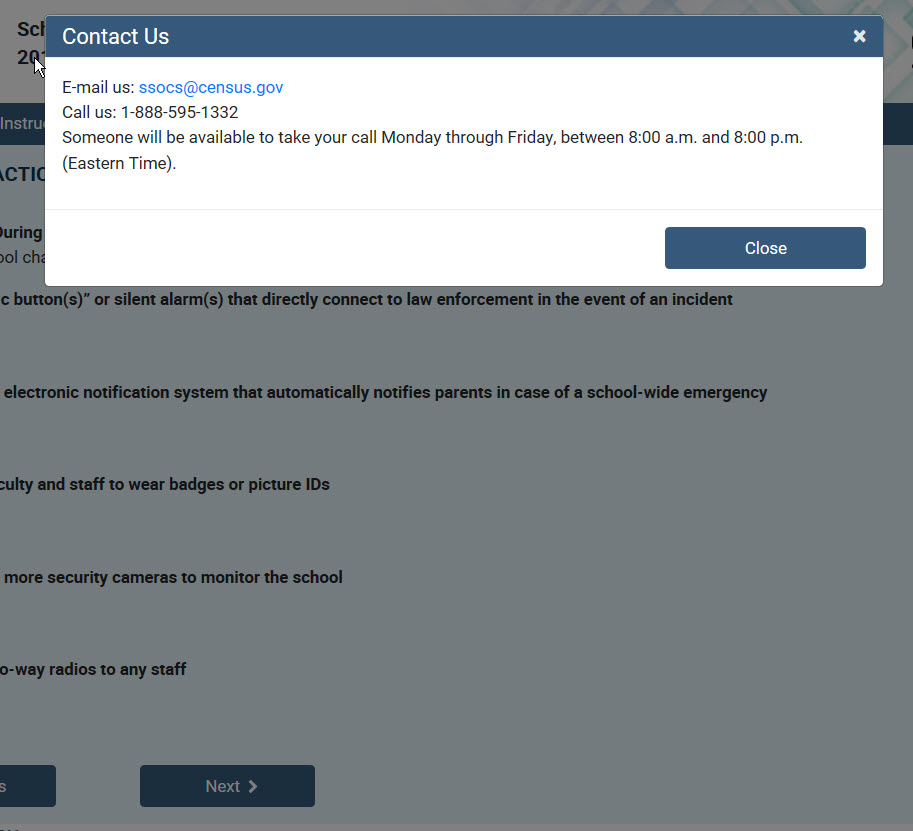
Text Reads (in black font):
“CONTACT US Return to Survey (button)
Email us: ssocs@census.gov
Call us: 1-888-595-1332
Someone will be available to take your call Monday through Friday, between 8:00 a.m. and 8:00 p.m. (Eastern Time).”
Item: Definitions Tab (definitions)
Return to Survey (button)
This will include terms and definitions that will be identical to the Definitions page on the paper version of the questionnaire (Appendix B).
Item: Accessibility Screen (accessibility)
Return to Survey (button)
This screen is accessible by clicking on the “Accessibility” link at the bottom of the page.
Text Reads As:
Accessibility
The Census Bureau is committed to making online forms and other public documents on its Internet server accessible to all. Currently, we are reviewing our web sites and making modifications to those pages, which are not in compliance with the Americans with Disabilities Act. We use Hypertext Markup Language (HTML) to create pages that are generally accessible to persons using screen-reading devices, and we are careful in our construction of HTML documents to ensure maximum accessibility. We include alternate text describing graphics.
Many Census Bureau Internet documents are in ASCII or HTML formats. These documents are accessible to persons using screen-reading software. We also have a large number of documents in Adobe Acrobat PDF (Portable Document Format) files. Currently, many people using screen-reading devices cannot read documents in PDF format, specifically those that were created from a scanned hard copy.
Adobe Systems, Inc. is producing various products designed to make Adobe Acrobat documents accessible to persons using screen-reading software. Adobe's accessibility web pages describe their efforts.
To allow us to better serve those with visual disabilities who are having difficulty accessing PDF documents; you may contact us directly for further assistance at 301-763-INFO (4636), 800-923-8282, or by submitting a request at ask.census.gov.
Item: Security Screen (security)
Return to Survey (button).
This screen is accessible by clicking on the “Security” link at the bottom of the page.
Text Reads As:
“Data are Encrypted at all Times
Our secure servers use Hypertext Transfer Protocol over Secure Socket Layer (HTTPS) to ensure the encrypted transmission of data between your browser and the U.S. Census Bureau. This means that instead of sending readable text over the Internet, both your browser and our servers encode (scramble) all text using a security key. That way, personal data sent to your browser and data you send back are extremely difficult to decode in the unlikely event of interception by an unauthorized party. As a result of this, your browser must be capable of using the required encryption protocol and strength in order to connect to our servers. If you cannot connect to our secure servers, please upgrade to a newer browser.
Third Party Identity Proofing
Our secure servers use a digital certificate (digital ID) issued by a trusted, third party Certificate Authority (CA) as proof of identity. The only way to be sure of a web site's authenticity is to view their digital ID. In this way, you can be assured that you are not being "spoofed" or tricked by an imposter. The digital ID will contain information such as the name of the organization that owns the web site, the site's registered internet name/address, and the name of the Certification Authority under which the digital ID was issued. The method for viewing a web site's Digital Certificate/ID varies depending on the web browser. Please see your browser's "Help" information for instructions on how to verify a web site's identity. “
2022 SSOCS Webpage Text
http://www.nces.ed.gov/surveys/ssocs
Header
<SSOCS logo> <School Survey on Crime and Safety (SSOCS)>
<Publications & Products> <SSOCS & SCS Table Library> <Staff>
Left panel
<Overview>
<Survey Topics>
<Data Products>
<Questionnaires>
<Join NewsFlash>
<Overview>
The School Survey on Crime and Safety (SSOCS) is the primary source of school-level data on crime and safety for the U.S. Department of Education, National Center for Education Statistics (NCES). The SSOCS is a nationally representative cross-sectional survey of 4,800 public elementary and secondary schools. To find out more information about SSOCS, please click on the questions below.
The School Survey on Crime and Safety (SSOCS) is the National Center for Education Statistics' sample survey of the nation's public schools designed to provide estimates of school crime, discipline, disorder, programs and policies. SSOCS is administered to public primary, middle, high, and combined school principals in the spring of even-numbered school years.
Approximately 4,800 public school principals are selected to receive the SSOCS questionnaire. The SSOCS sample is large enough to provide national estimates of all public schools, while taking into account a number of factors, including the level of instruction, student enrollment size, and urbanicity.
SSOCS is administered during the spring of the school year to allow principals to report the most complete information possible. SSOCS was first administered to principals in the spring of the 1999–2000 school year. It has since been administered in the springs of the 1999–2000, 2003–04, 2005–06, 2007–08, 2009–10, 2015–16, and 2017–18 school years. It will be administered again in the spring of the 2019–20 school year. Sampling details for each SSOCS administration can be found in its data products.
The
SSOCS questionnaire asks principals to report on a variety of topics
related to crime and safety, including:![]()
School Practices and Programs,
Parent and Community Involvement at School,
School Security Staff,
School Mental Health Services,
Staff Training and Practices,
Limitations on Crime Prevention,
Incidents,
Disciplinary problems and actions, and
Other school characteristics related to school crime.
Where can I learn more about SSOCS and other crime and safety data collections?
The SSOCS Publications and Products page contains SSOCS data products, reports, and other publications. The Crime and Safety Surveys page has information on SSOCS and other surveys.
<Survey Topics>
Sections of the SSOCS questionnaire are composed of items about specific topics. Click on the section name to read more about these topics.
![]() The
first section of SSOCS, entitled "School Practices and
Programs," addresses current school practices and programs
relating to crime and discipline. Numerous practices and programs
are included in this section to inform procedures by which schools
attempt to prevent and reduce crime, disorder, and violence, as well
as procedures to ensure the most effective response to a myriad of
potential crisis situations. Although the data are not intended to
be used to evaluate the state of national school practices, the
variables detailed in this section arguably present a foundation
from which policymakers and researchers can begin to understand
environments in which crime occurs and may be used as a catalyst for
influencing safer schools
The
first section of SSOCS, entitled "School Practices and
Programs," addresses current school practices and programs
relating to crime and discipline. Numerous practices and programs
are included in this section to inform procedures by which schools
attempt to prevent and reduce crime, disorder, and violence, as well
as procedures to ensure the most effective response to a myriad of
potential crisis situations. Although the data are not intended to
be used to evaluate the state of national school practices, the
variables detailed in this section arguably present a foundation
from which policymakers and researchers can begin to understand
environments in which crime occurs and may be used as a catalyst for
influencing safer schools
![]()
![]() The
second section of SSOCS, "Parent and Community Involvement at
School," seeks to collect information about efforts on behalf
of schools to involve parents in maintaining school discipline and
in responding to student problem behaviors. It also addresses the
level of parent or guardian participation in school-related
activities. This section additionally seeks to inform the extent to
which community groups and related organizations and agencies are
involved in schools’ efforts to promote safe schools,
including juvenile justice agencies, social service agencies, and
religious organizations.
The
second section of SSOCS, "Parent and Community Involvement at
School," seeks to collect information about efforts on behalf
of schools to involve parents in maintaining school discipline and
in responding to student problem behaviors. It also addresses the
level of parent or guardian participation in school-related
activities. This section additionally seeks to inform the extent to
which community groups and related organizations and agencies are
involved in schools’ efforts to promote safe schools,
including juvenile justice agencies, social service agencies, and
religious organizations.
![]()
School Security Staff
This third section of SSOCS, "School Security Staff," asks respondents about the presence of security guards, security personnel, and sworn law enforcement officers at their school. These questions seek to collect data that will illustrate the coexistence of the presence of these personnel and reports of school crime. This section also asks the respondent questions about the presence of school security during various times throughout the school day and after school hours, the number of full- and part-time security employees, whether they were armed, as well as their participation in particular school activities such as training teachers and staff in school safety or crime prevention and mentoring students.
School Mental Health Services
 The
fourth section asks respondents whether their school provided
diagnostic mental health assessments and treatment to students and
whether these services were provided in school or outside of
school. Assessing the types of mental health services provided by
schools as well as the location of these services demonstrates how
well-equipped schools are to deal with students who have mental
health disorders.
The
fourth section asks respondents whether their school provided
diagnostic mental health assessments and treatment to students and
whether these services were provided in school or outside of
school. Assessing the types of mental health services provided by
schools as well as the location of these services demonstrates how
well-equipped schools are to deal with students who have mental
health disorders.
Staff Training and Practices
The
fifth section of SSOCS, entitled "Staff Training and
Practices," asks respondents about training provided by the
school or school district for classroom teachers or aides. Topics
addressed include classroom management, school-wide discipline
policies and practices related to violence, safety procedures, and
the identification of potentially violent students and those that
are using illegal substances. This section also enquires about
training for positive behavioral intervention strategies. A school’s
use of such profiles may affect school-wide levels of discipline,
yet also serve to achieve prevention through student-specific
targeted interventions.![]()
![]()
![]() The
sixth section of SSOCS, entitled "Limitations on Crime
Prevention," asks respondents whether their efforts to reduce
or prevent crime have been constrained by any factors related to
teachers, parents, students, or administrative policies. Such
limitations include inadequate teacher training or lack of teacher
support for school policies, likelihood of complaints from parents,
fear of student retaliation, and federal, state, or district
policies on discipline and safety. The data from this section can be
used to determine whether these limitations are indeed correlated
with school crime.
The
sixth section of SSOCS, entitled "Limitations on Crime
Prevention," asks respondents whether their efforts to reduce
or prevent crime have been constrained by any factors related to
teachers, parents, students, or administrative policies. Such
limitations include inadequate teacher training or lack of teacher
support for school policies, likelihood of complaints from parents,
fear of student retaliation, and federal, state, or district
policies on discipline and safety. The data from this section can be
used to determine whether these limitations are indeed correlated
with school crime.
![]()
![]() The
seventh section of SSOCS, "Number of Incidents," asks
respondents about the frequency of a range of serious criminal
incidents recorded as occurring on their school campuses. It is
important to note that this section refers to specific incidents,
not the number of victims or offenders, and the respondent was asked
to include recorded incidents committed by both students and
non-students. In addition to the total number of recorded incidents,
respondents were asked to report how many of the recorded incidents
were reported to the police. The criminal incidents this section
discusses include rape, robbery, physical attack, theft, possession
of a weapon, alcohol or illegal drugs, and vandalism. It also asks
for the number of hate crimes, shootings, and homicides.
The
seventh section of SSOCS, "Number of Incidents," asks
respondents about the frequency of a range of serious criminal
incidents recorded as occurring on their school campuses. It is
important to note that this section refers to specific incidents,
not the number of victims or offenders, and the respondent was asked
to include recorded incidents committed by both students and
non-students. In addition to the total number of recorded incidents,
respondents were asked to report how many of the recorded incidents
were reported to the police. The criminal incidents this section
discusses include rape, robbery, physical attack, theft, possession
of a weapon, alcohol or illegal drugs, and vandalism. It also asks
for the number of hate crimes, shootings, and homicides.
![]()
![]() The
eighth section of SSOCS, entitled "Disciplinary Problems and
Actions," asks about the degree to which schools face a variety
of disciplinary problems and their response. School administrators
were asked about the availability and use of a number of
disciplinary actions, as well as the use of disciplinary actions
including removals from school, transfers, and out-of-school
suspensions for specified offenses. The data provided by this
section will be helpful in assessing the impact of schools’
control of lesser violations, as well as providing another measure
of the disciplinary measures used in U.S. schools.
The
eighth section of SSOCS, entitled "Disciplinary Problems and
Actions," asks about the degree to which schools face a variety
of disciplinary problems and their response. School administrators
were asked about the availability and use of a number of
disciplinary actions, as well as the use of disciplinary actions
including removals from school, transfers, and out-of-school
suspensions for specified offenses. The data provided by this
section will be helpful in assessing the impact of schools’
control of lesser violations, as well as providing another measure
of the disciplinary measures used in U.S. schools.
![]()
The ninth section of SSOCS, entitled "School Characteristics," asks respondents about the structural characteristics of the school campus and features of the student body. Variables include total enrollment, English proficiency, percentage of students eligible for free or reduced-price lunch, percentage male enrollment, typical number of classroom changes, level of crime where the school is located and in the areas where students live, and the number of student transfers in and out of their particular school. Correlating these characteristics with incidence of crime and safety practices will assist in developing targeted efforts to address the specific needs of schools.
<Data Products>
Public-use data files from past iterations of SSOCS can be downloaded in various software formats by clicking on the links below. Survey documentation can be viewed, downloaded, and printed as PDF files. ASCII files are below and can be used with the setup files provided to read in data to formats that are not provided on this page. To request access to restricted-use SSOCS data, please visit the restricted-use data licenses page.
School Survey on Crime and Safety (SSOCS)
2017-18 SSOCS Data Products (link goes to section below)
2015-16 SSOCS Data Products (link goes to section below)
2009-10
SSOCS Data Products
(link goes to section below)
2007-08
SSOCS Data Products
(link goes to section below)
2005-06
SSOCS Data Products
(link goes to section below)
2003–04
SSOCS Data Products
(link goes to section below)
1999–2000
SSOCS Data Products
(link goes to section below)

2017–18 SSOCS Data Products
Data Files

2015–16 SSOCS Data Products
Data Files

2009–10 SSOCS Data Products
Data Files

2007–08 SSOCS Data Products
Data Files
SAS Files
SPSS File
STATA File
ASCII (Text) Files
Data Documentation

2005–06 SSOCS Data Products
Data Files
SAS Files
SPSS File
STATA File
ASCII (Text) Files
Data Documentation

2003–04 SSOCS Data Products
Data Files
SAS Files
SPSS File
ASCII (Text) Files
Data Documentation

1999–2000 SSOCS Data Products
Data Files
SSOCS Public-Use Data CD-ROM
SAS Files
SPSS Files
STATA File
ASCII (Text) Files
Data Documentation
<Questionnaires>
The questionnaires below can be viewed, downloaded, and printed as PDF files.
Downloadable Questionnaires
<list of questionnaires>
Visit the help section for help on viewing, downloading, and printing PDF files.
<Join NewsFlash> (link goes to NCES NewsFlash homepage for viewers to sign up)
Header: <Publications and Products>
<Data Products>
List of SSOCS-related products
<Reports>
List of products including SSOCS data (Condition of Education, Indicators of School Crime)
<Shorter Publications>
List of brochures
Header: <SSOCS & SCS Table Library>
(each bullet links to a drop-down menu of a list of tables related to that topic)
|
|
SSOCS is a nationally representative sample of regular public elementary, middle, secondary and combined schools. Completed by school principals, the survey asks about school safety practices, school violence prevention programs, and the frequency of school crime and violence.
SCS is a national survey of students ages 12 through 18 in U.S. public and private elementary, middle, and high schools. Created as a supplement to the NCVS, SCS collects information about characteristics of school-related crime, victimization, and safety.
View complete list of SSOCS and SCS data tables. (this link goes to a page with a complete listing of all crime-related tables)
Clicking
on a plus sign (+) will display the contents of a publication.
Clicking on "Show All" will open all sections and
sub-sections, including all tables. Click on the minus sign (-) or
"Hide All" to close sections.
![]() indicates
a recently added or modified table.
indicates
a recently added or modified table.
Header: <Staff>
Survey Area: Crime and Safety Surveys - CSS
Staff: Hansen, Rachel
| File Type | application/vnd.openxmlformats-officedocument.wordprocessingml.document |
| File Title | Advance letter 2/16/2010 |
| Author | thoma440 |
| File Modified | 0000-00-00 |
| File Created | 2022-02-08 |
© 2026 OMB.report | Privacy Policy